Urban Tourism in Cambridge: Resident Perspectives and Impacts
VerifiedAdded on 2024/05/16
|36
|6018
|138
AI Summary
This field report explores the perspectives of residents in Cambridge, UK, on the impact of urban tourism. Through a survey of 10 local residents, the report investigates the positive and negative effects of tourism on the city's economy, environment, and socio-cultural fabric. The findings reveal a complex relationship between tourism and local communities, highlighting the need for sustainable tourism practices to balance economic benefits with the preservation of Cambridge's unique character.
Contribute Materials
Your contribution can guide someone’s learning journey. Share your
documents today.
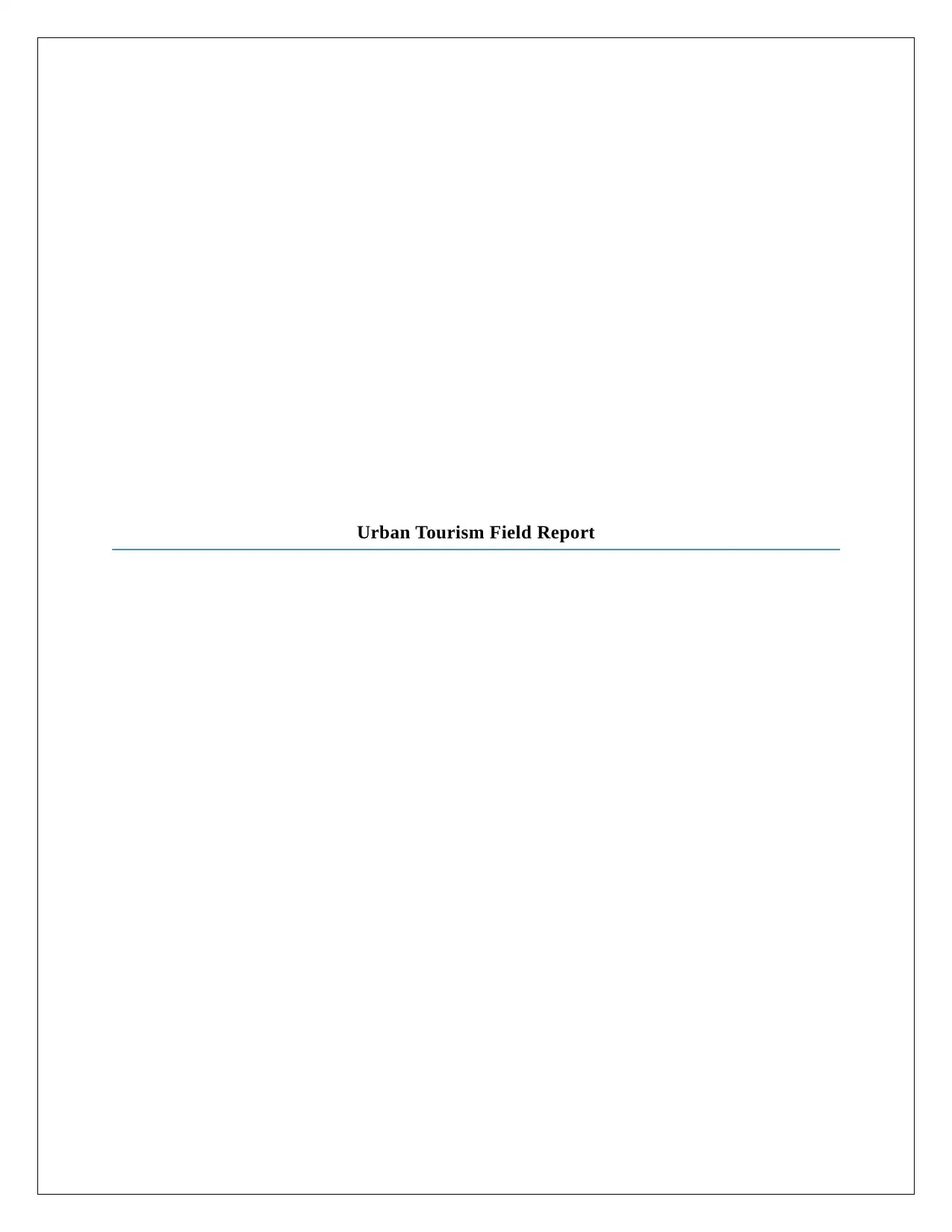
Urban Tourism Field Report
Secure Best Marks with AI Grader
Need help grading? Try our AI Grader for instant feedback on your assignments.
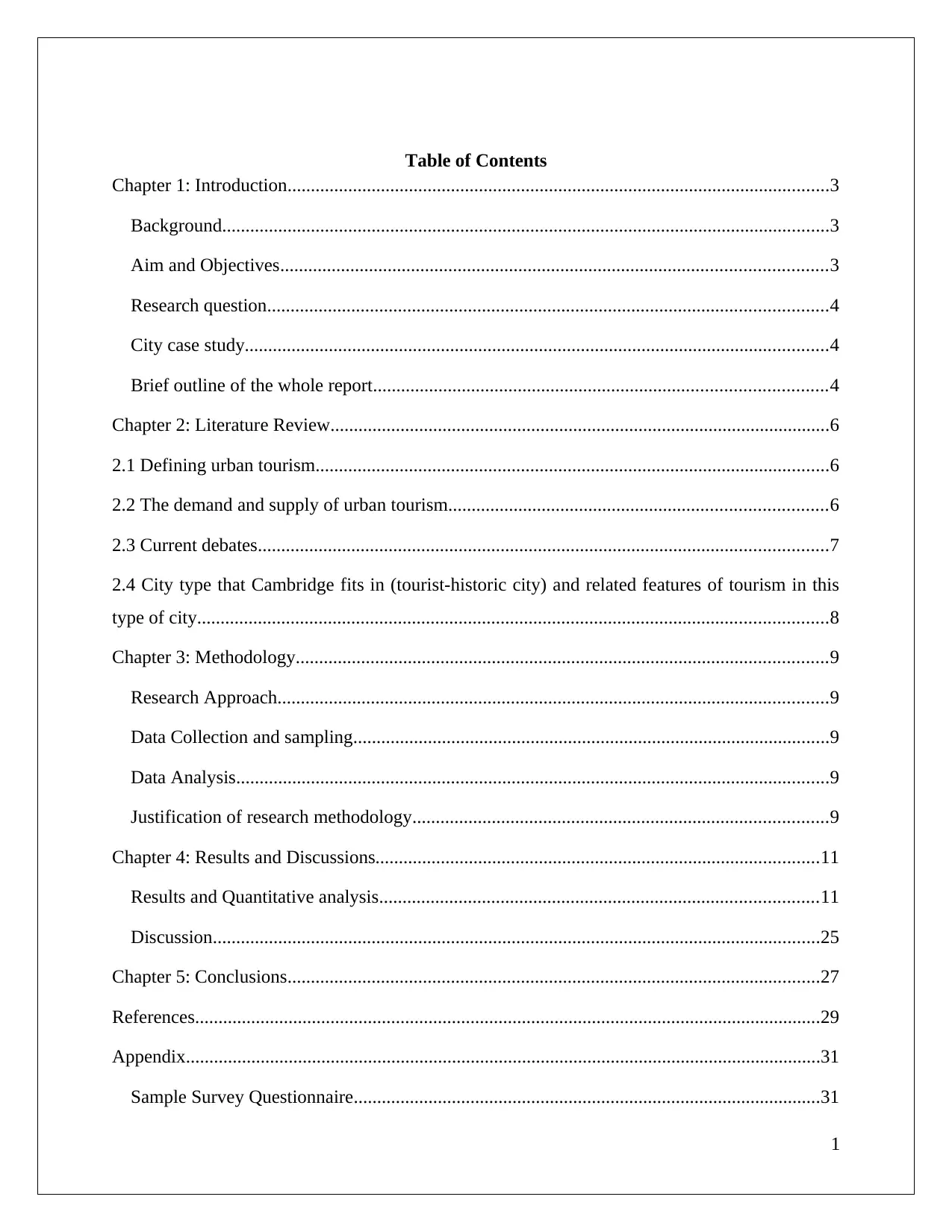
Table of Contents
Chapter 1: Introduction....................................................................................................................3
Background..................................................................................................................................3
Aim and Objectives.....................................................................................................................3
Research question........................................................................................................................4
City case study.............................................................................................................................4
Brief outline of the whole report.................................................................................................4
Chapter 2: Literature Review...........................................................................................................6
2.1 Defining urban tourism..............................................................................................................6
2.2 The demand and supply of urban tourism.................................................................................6
2.3 Current debates..........................................................................................................................7
2.4 City type that Cambridge fits in (tourist-historic city) and related features of tourism in this
type of city.......................................................................................................................................8
Chapter 3: Methodology..................................................................................................................9
Research Approach......................................................................................................................9
Data Collection and sampling......................................................................................................9
Data Analysis...............................................................................................................................9
Justification of research methodology.........................................................................................9
Chapter 4: Results and Discussions...............................................................................................11
Results and Quantitative analysis..............................................................................................11
Discussion..................................................................................................................................25
Chapter 5: Conclusions..................................................................................................................27
References......................................................................................................................................29
Appendix........................................................................................................................................31
Sample Survey Questionnaire....................................................................................................31
1
Chapter 1: Introduction....................................................................................................................3
Background..................................................................................................................................3
Aim and Objectives.....................................................................................................................3
Research question........................................................................................................................4
City case study.............................................................................................................................4
Brief outline of the whole report.................................................................................................4
Chapter 2: Literature Review...........................................................................................................6
2.1 Defining urban tourism..............................................................................................................6
2.2 The demand and supply of urban tourism.................................................................................6
2.3 Current debates..........................................................................................................................7
2.4 City type that Cambridge fits in (tourist-historic city) and related features of tourism in this
type of city.......................................................................................................................................8
Chapter 3: Methodology..................................................................................................................9
Research Approach......................................................................................................................9
Data Collection and sampling......................................................................................................9
Data Analysis...............................................................................................................................9
Justification of research methodology.........................................................................................9
Chapter 4: Results and Discussions...............................................................................................11
Results and Quantitative analysis..............................................................................................11
Discussion..................................................................................................................................25
Chapter 5: Conclusions..................................................................................................................27
References......................................................................................................................................29
Appendix........................................................................................................................................31
Sample Survey Questionnaire....................................................................................................31
1
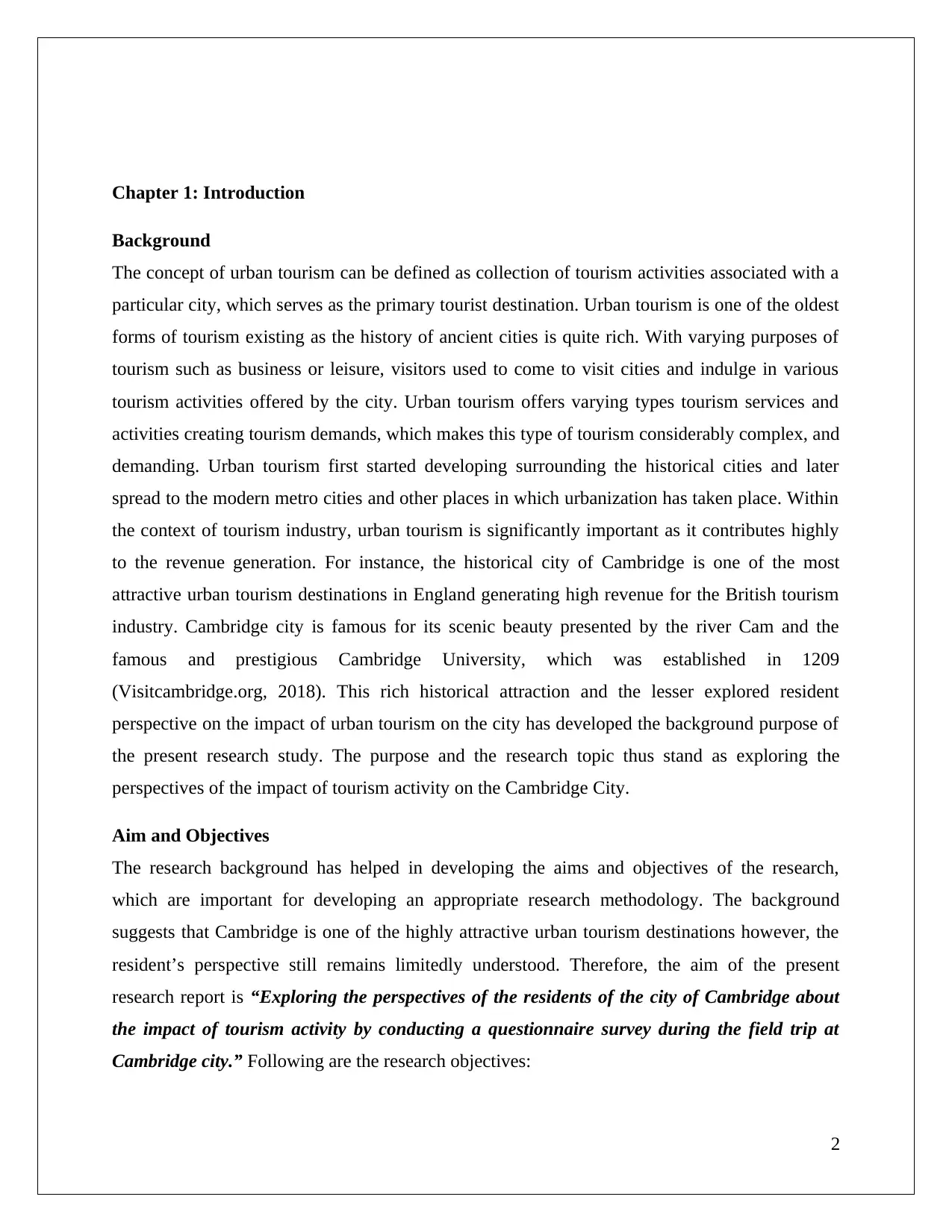
Chapter 1: Introduction
Background
The concept of urban tourism can be defined as collection of tourism activities associated with a
particular city, which serves as the primary tourist destination. Urban tourism is one of the oldest
forms of tourism existing as the history of ancient cities is quite rich. With varying purposes of
tourism such as business or leisure, visitors used to come to visit cities and indulge in various
tourism activities offered by the city. Urban tourism offers varying types tourism services and
activities creating tourism demands, which makes this type of tourism considerably complex, and
demanding. Urban tourism first started developing surrounding the historical cities and later
spread to the modern metro cities and other places in which urbanization has taken place. Within
the context of tourism industry, urban tourism is significantly important as it contributes highly
to the revenue generation. For instance, the historical city of Cambridge is one of the most
attractive urban tourism destinations in England generating high revenue for the British tourism
industry. Cambridge city is famous for its scenic beauty presented by the river Cam and the
famous and prestigious Cambridge University, which was established in 1209
(Visitcambridge.org, 2018). This rich historical attraction and the lesser explored resident
perspective on the impact of urban tourism on the city has developed the background purpose of
the present research study. The purpose and the research topic thus stand as exploring the
perspectives of the impact of tourism activity on the Cambridge City.
Aim and Objectives
The research background has helped in developing the aims and objectives of the research,
which are important for developing an appropriate research methodology. The background
suggests that Cambridge is one of the highly attractive urban tourism destinations however, the
resident’s perspective still remains limitedly understood. Therefore, the aim of the present
research report is “Exploring the perspectives of the residents of the city of Cambridge about
the impact of tourism activity by conducting a questionnaire survey during the field trip at
Cambridge city.” Following are the research objectives:
2
Background
The concept of urban tourism can be defined as collection of tourism activities associated with a
particular city, which serves as the primary tourist destination. Urban tourism is one of the oldest
forms of tourism existing as the history of ancient cities is quite rich. With varying purposes of
tourism such as business or leisure, visitors used to come to visit cities and indulge in various
tourism activities offered by the city. Urban tourism offers varying types tourism services and
activities creating tourism demands, which makes this type of tourism considerably complex, and
demanding. Urban tourism first started developing surrounding the historical cities and later
spread to the modern metro cities and other places in which urbanization has taken place. Within
the context of tourism industry, urban tourism is significantly important as it contributes highly
to the revenue generation. For instance, the historical city of Cambridge is one of the most
attractive urban tourism destinations in England generating high revenue for the British tourism
industry. Cambridge city is famous for its scenic beauty presented by the river Cam and the
famous and prestigious Cambridge University, which was established in 1209
(Visitcambridge.org, 2018). This rich historical attraction and the lesser explored resident
perspective on the impact of urban tourism on the city has developed the background purpose of
the present research study. The purpose and the research topic thus stand as exploring the
perspectives of the impact of tourism activity on the Cambridge City.
Aim and Objectives
The research background has helped in developing the aims and objectives of the research,
which are important for developing an appropriate research methodology. The background
suggests that Cambridge is one of the highly attractive urban tourism destinations however, the
resident’s perspective still remains limitedly understood. Therefore, the aim of the present
research report is “Exploring the perspectives of the residents of the city of Cambridge about
the impact of tourism activity by conducting a questionnaire survey during the field trip at
Cambridge city.” Following are the research objectives:
2
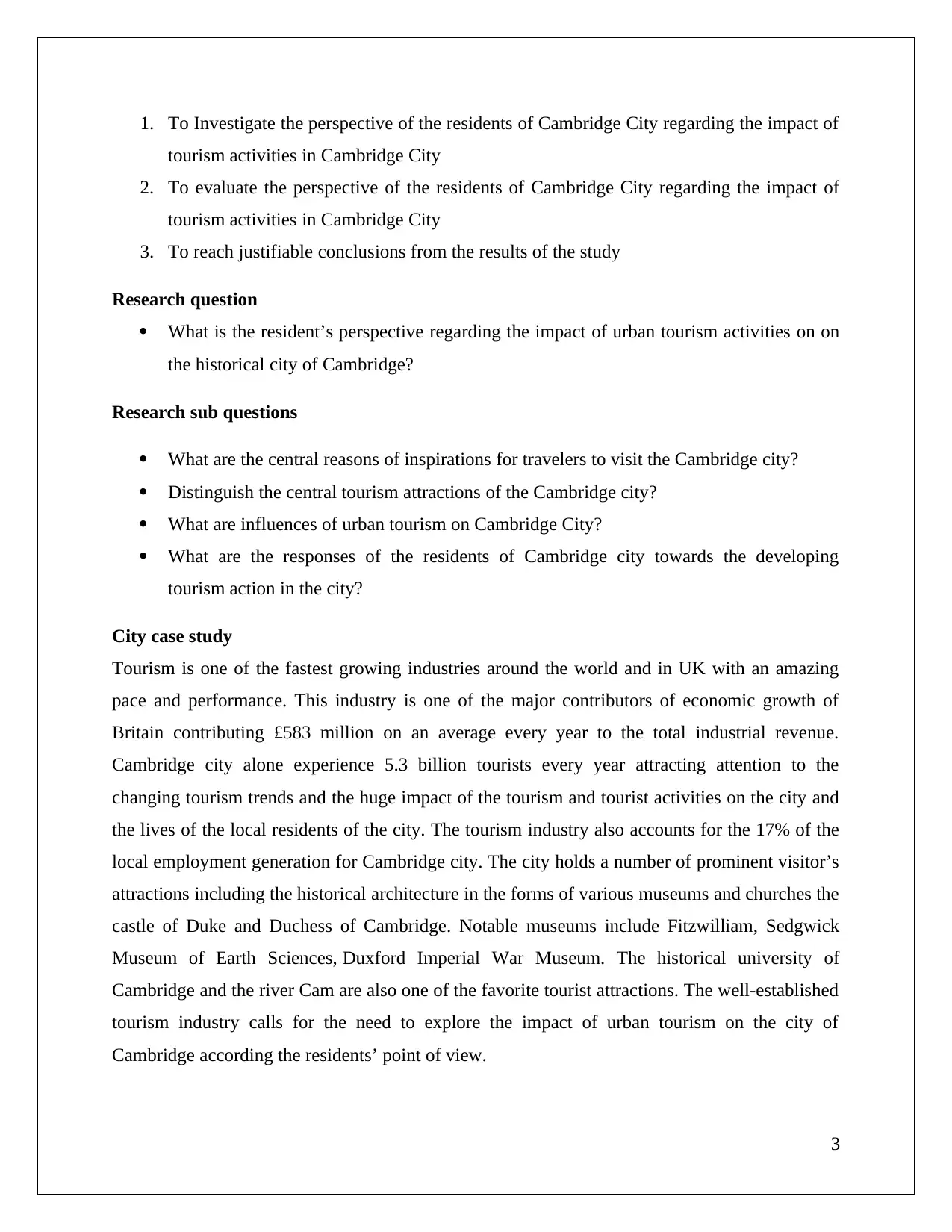
1. To Investigate the perspective of the residents of Cambridge City regarding the impact of
tourism activities in Cambridge City
2. To evaluate the perspective of the residents of Cambridge City regarding the impact of
tourism activities in Cambridge City
3. To reach justifiable conclusions from the results of the study
Research question
What is the resident’s perspective regarding the impact of urban tourism activities on on
the historical city of Cambridge?
Research sub questions
What are the central reasons of inspirations for travelers to visit the Cambridge city?
Distinguish the central tourism attractions of the Cambridge city?
What are influences of urban tourism on Cambridge City?
What are the responses of the residents of Cambridge city towards the developing
tourism action in the city?
City case study
Tourism is one of the fastest growing industries around the world and in UK with an amazing
pace and performance. This industry is one of the major contributors of economic growth of
Britain contributing £583 million on an average every year to the total industrial revenue.
Cambridge city alone experience 5.3 billion tourists every year attracting attention to the
changing tourism trends and the huge impact of the tourism and tourist activities on the city and
the lives of the local residents of the city. The tourism industry also accounts for the 17% of the
local employment generation for Cambridge city. The city holds a number of prominent visitor’s
attractions including the historical architecture in the forms of various museums and churches the
castle of Duke and Duchess of Cambridge. Notable museums include Fitzwilliam, Sedgwick
Museum of Earth Sciences, Duxford Imperial War Museum. The historical university of
Cambridge and the river Cam are also one of the favorite tourist attractions. The well-established
tourism industry calls for the need to explore the impact of urban tourism on the city of
Cambridge according the residents’ point of view.
3
tourism activities in Cambridge City
2. To evaluate the perspective of the residents of Cambridge City regarding the impact of
tourism activities in Cambridge City
3. To reach justifiable conclusions from the results of the study
Research question
What is the resident’s perspective regarding the impact of urban tourism activities on on
the historical city of Cambridge?
Research sub questions
What are the central reasons of inspirations for travelers to visit the Cambridge city?
Distinguish the central tourism attractions of the Cambridge city?
What are influences of urban tourism on Cambridge City?
What are the responses of the residents of Cambridge city towards the developing
tourism action in the city?
City case study
Tourism is one of the fastest growing industries around the world and in UK with an amazing
pace and performance. This industry is one of the major contributors of economic growth of
Britain contributing £583 million on an average every year to the total industrial revenue.
Cambridge city alone experience 5.3 billion tourists every year attracting attention to the
changing tourism trends and the huge impact of the tourism and tourist activities on the city and
the lives of the local residents of the city. The tourism industry also accounts for the 17% of the
local employment generation for Cambridge city. The city holds a number of prominent visitor’s
attractions including the historical architecture in the forms of various museums and churches the
castle of Duke and Duchess of Cambridge. Notable museums include Fitzwilliam, Sedgwick
Museum of Earth Sciences, Duxford Imperial War Museum. The historical university of
Cambridge and the river Cam are also one of the favorite tourist attractions. The well-established
tourism industry calls for the need to explore the impact of urban tourism on the city of
Cambridge according the residents’ point of view.
3
Paraphrase This Document
Need a fresh take? Get an instant paraphrase of this document with our AI Paraphraser

Brief outline of the whole report
The report includes an exploration of the resident’s perspectives on the various impacts of
tourism activity on the city of Cambridge using a survey done during the field trip at the city.
The result and discussions helps the researcher in developing conclusions that achieved the
research objectives successfully.
4
The report includes an exploration of the resident’s perspectives on the various impacts of
tourism activity on the city of Cambridge using a survey done during the field trip at the city.
The result and discussions helps the researcher in developing conclusions that achieved the
research objectives successfully.
4

Chapter 2: Literature Review
2.1 Defining urban tourism
The term urban tourism denotes the tourism in urban areas. According to Miller et al., (2015), the
urban tourism is comparatively an ancient form of tourism. The people of Mesopotamia and
Babylon used to visit several places for business purpose. Urbanization is a prime force
contributing to the development of cities and towns, where people live, shop and work.
Therefore, the renowned critic Spirou (2011) has commented that the cities and towns provide
the context for a diverse range of cultural, social and economic activities. The urban tourism
interlinked with the gastronomy tourism, shopping tourism, cultural tourism and others. The
nature of urban tourism is to grow the business, adventure, fashion and employment in the
particular city. The urban tourism contributes to positioning the towns, cities and megacities in
the global networks. The understanding of the term urban tourism incorporates with residents,
temporary or permanent, who consume the city along with the tourists. The enhancement of the
positive image of the city is often integral to the development of urban tourism. Since the end of
nineteenth century, the urban tourism has rapidly developed and witnessed a radical change in
the influx of the international as well as domestic tourist. AlSayyad (2013) commented that the
developed infrastructure and socio-cultural elements are responsible for this remarkable growth.
The urban tourism brings the economic growth and elastics the scope of employment in the
particular place or city. The tourist’s quest for knowledge and the trend to escape from the busy
schedule are increasing the tourists’ influx in urban areas.
2.2 The demand and supply of urban tourism
The demand and supply chain of urban tourism is the fuel to run the tourism service in cities and
towns. The demand and supply are interdependent with each other. The famous scholar Mordue
(2017) stated that the appropriate identification of the demand graph is necessary to estimate the
supply rate. The demand of the tourism refers to the individual number of visit to any particular
place in a specific period of time. On the other hand, Preston (2011) stated that the supply refers
to the identification of the responses in accordance with the market demand. The end of the
5
2.1 Defining urban tourism
The term urban tourism denotes the tourism in urban areas. According to Miller et al., (2015), the
urban tourism is comparatively an ancient form of tourism. The people of Mesopotamia and
Babylon used to visit several places for business purpose. Urbanization is a prime force
contributing to the development of cities and towns, where people live, shop and work.
Therefore, the renowned critic Spirou (2011) has commented that the cities and towns provide
the context for a diverse range of cultural, social and economic activities. The urban tourism
interlinked with the gastronomy tourism, shopping tourism, cultural tourism and others. The
nature of urban tourism is to grow the business, adventure, fashion and employment in the
particular city. The urban tourism contributes to positioning the towns, cities and megacities in
the global networks. The understanding of the term urban tourism incorporates with residents,
temporary or permanent, who consume the city along with the tourists. The enhancement of the
positive image of the city is often integral to the development of urban tourism. Since the end of
nineteenth century, the urban tourism has rapidly developed and witnessed a radical change in
the influx of the international as well as domestic tourist. AlSayyad (2013) commented that the
developed infrastructure and socio-cultural elements are responsible for this remarkable growth.
The urban tourism brings the economic growth and elastics the scope of employment in the
particular place or city. The tourist’s quest for knowledge and the trend to escape from the busy
schedule are increasing the tourists’ influx in urban areas.
2.2 The demand and supply of urban tourism
The demand and supply chain of urban tourism is the fuel to run the tourism service in cities and
towns. The demand and supply are interdependent with each other. The famous scholar Mordue
(2017) stated that the appropriate identification of the demand graph is necessary to estimate the
supply rate. The demand of the tourism refers to the individual number of visit to any particular
place in a specific period of time. On the other hand, Preston (2011) stated that the supply refers
to the identification of the responses in accordance with the market demand. The end of the
5
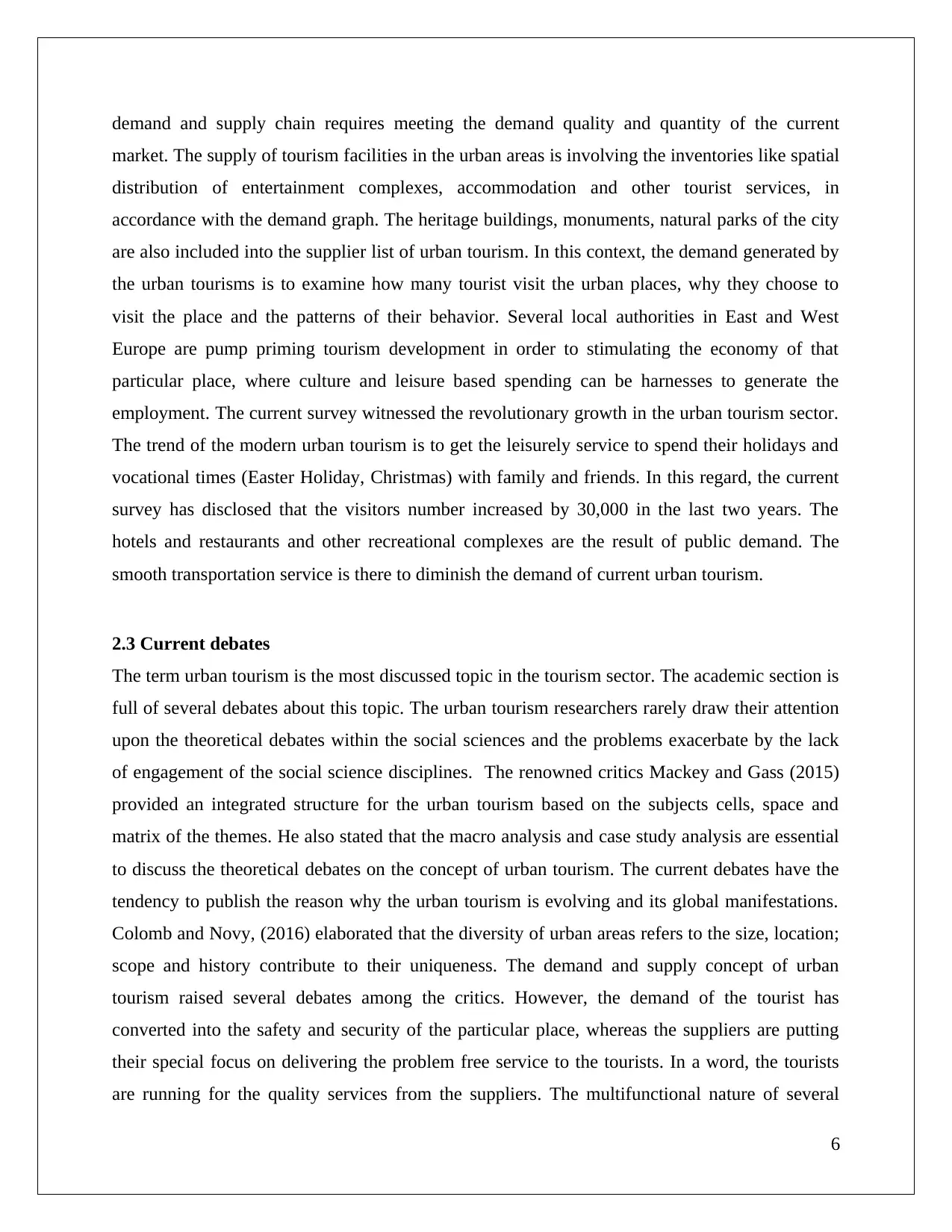
demand and supply chain requires meeting the demand quality and quantity of the current
market. The supply of tourism facilities in the urban areas is involving the inventories like spatial
distribution of entertainment complexes, accommodation and other tourist services, in
accordance with the demand graph. The heritage buildings, monuments, natural parks of the city
are also included into the supplier list of urban tourism. In this context, the demand generated by
the urban tourisms is to examine how many tourist visit the urban places, why they choose to
visit the place and the patterns of their behavior. Several local authorities in East and West
Europe are pump priming tourism development in order to stimulating the economy of that
particular place, where culture and leisure based spending can be harnesses to generate the
employment. The current survey witnessed the revolutionary growth in the urban tourism sector.
The trend of the modern urban tourism is to get the leisurely service to spend their holidays and
vocational times (Easter Holiday, Christmas) with family and friends. In this regard, the current
survey has disclosed that the visitors number increased by 30,000 in the last two years. The
hotels and restaurants and other recreational complexes are the result of public demand. The
smooth transportation service is there to diminish the demand of current urban tourism.
2.3 Current debates
The term urban tourism is the most discussed topic in the tourism sector. The academic section is
full of several debates about this topic. The urban tourism researchers rarely draw their attention
upon the theoretical debates within the social sciences and the problems exacerbate by the lack
of engagement of the social science disciplines. The renowned critics Mackey and Gass (2015)
provided an integrated structure for the urban tourism based on the subjects cells, space and
matrix of the themes. He also stated that the macro analysis and case study analysis are essential
to discuss the theoretical debates on the concept of urban tourism. The current debates have the
tendency to publish the reason why the urban tourism is evolving and its global manifestations.
Colomb and Novy, (2016) elaborated that the diversity of urban areas refers to the size, location;
scope and history contribute to their uniqueness. The demand and supply concept of urban
tourism raised several debates among the critics. However, the demand of the tourist has
converted into the safety and security of the particular place, whereas the suppliers are putting
their special focus on delivering the problem free service to the tourists. In a word, the tourists
are running for the quality services from the suppliers. The multifunctional nature of several
6
market. The supply of tourism facilities in the urban areas is involving the inventories like spatial
distribution of entertainment complexes, accommodation and other tourist services, in
accordance with the demand graph. The heritage buildings, monuments, natural parks of the city
are also included into the supplier list of urban tourism. In this context, the demand generated by
the urban tourisms is to examine how many tourist visit the urban places, why they choose to
visit the place and the patterns of their behavior. Several local authorities in East and West
Europe are pump priming tourism development in order to stimulating the economy of that
particular place, where culture and leisure based spending can be harnesses to generate the
employment. The current survey witnessed the revolutionary growth in the urban tourism sector.
The trend of the modern urban tourism is to get the leisurely service to spend their holidays and
vocational times (Easter Holiday, Christmas) with family and friends. In this regard, the current
survey has disclosed that the visitors number increased by 30,000 in the last two years. The
hotels and restaurants and other recreational complexes are the result of public demand. The
smooth transportation service is there to diminish the demand of current urban tourism.
2.3 Current debates
The term urban tourism is the most discussed topic in the tourism sector. The academic section is
full of several debates about this topic. The urban tourism researchers rarely draw their attention
upon the theoretical debates within the social sciences and the problems exacerbate by the lack
of engagement of the social science disciplines. The renowned critics Mackey and Gass (2015)
provided an integrated structure for the urban tourism based on the subjects cells, space and
matrix of the themes. He also stated that the macro analysis and case study analysis are essential
to discuss the theoretical debates on the concept of urban tourism. The current debates have the
tendency to publish the reason why the urban tourism is evolving and its global manifestations.
Colomb and Novy, (2016) elaborated that the diversity of urban areas refers to the size, location;
scope and history contribute to their uniqueness. The demand and supply concept of urban
tourism raised several debates among the critics. However, the demand of the tourist has
converted into the safety and security of the particular place, whereas the suppliers are putting
their special focus on delivering the problem free service to the tourists. In a word, the tourists
are running for the quality services from the suppliers. The multifunctional nature of several
6
Secure Best Marks with AI Grader
Need help grading? Try our AI Grader for instant feedback on your assignments.

cities is the major concern of the critics if they are a part of only urban tourism or business
tourism. However, the business tourism is closely interlinked with the urban tourism. The
globalization and industrialization in various are grabbing the attention of the critics to enhance
their area of knowledge. The specialist tour operators are also creating the confusion to indentify
the type of cities and other destinations.
2.4 City type that Cambridge fits in (tourist-historic city) and related features of tourism in
this type of city
According to the famous scholars García-Hernández et al. (2017), the city of Cambridge is the
most renowned tourist historic city. However, the city is the evidence of the early Anglo Saxon
period. The exactors discovered the existence of Bronze period. The River Cam is another
historical river, which is flowing beside the city of Cambridge. Major number of tourists visits
this city in order to diminish their quest for historical knowledge. The Cambridge University is
the most renowned and historical university of the world. The Castle Mound, King’s College
chapel, Fitzwilliam Monument, Imperial war museum and several monuments present the city as
a historical one. The urban tourism of this city is interlinked with the heritage and cultural
tourism.
Pinkster and Boterman, (2017) stated that the city is enriched with innumerable historical
evidences. Similarly, the botanical garden and mathematical bridge are the popular historical
place of city of Cambridge. The city of Cambridge is completely satisfies the features of a
tourist-historic-city of urban tourism. Major portion of the tourist come to visit the city, belongs
to the educational sectors. The researchers and students group visit this place for the valuable
historical essence of the city. The service quality of the tour operators is not a major issue to the
tourists. Therefore, they only look for historical knowledge. The local government of the city has
taken several initiatives to maintain the historical buildings and monuments. The report of
current survey has disclosed that most of the tourist used to spend more than two days to visit the
city for tourism. This rapid growth of the urban tourism in the city has enlarged the employment
scope for the local residents.
7
tourism. However, the business tourism is closely interlinked with the urban tourism. The
globalization and industrialization in various are grabbing the attention of the critics to enhance
their area of knowledge. The specialist tour operators are also creating the confusion to indentify
the type of cities and other destinations.
2.4 City type that Cambridge fits in (tourist-historic city) and related features of tourism in
this type of city
According to the famous scholars García-Hernández et al. (2017), the city of Cambridge is the
most renowned tourist historic city. However, the city is the evidence of the early Anglo Saxon
period. The exactors discovered the existence of Bronze period. The River Cam is another
historical river, which is flowing beside the city of Cambridge. Major number of tourists visits
this city in order to diminish their quest for historical knowledge. The Cambridge University is
the most renowned and historical university of the world. The Castle Mound, King’s College
chapel, Fitzwilliam Monument, Imperial war museum and several monuments present the city as
a historical one. The urban tourism of this city is interlinked with the heritage and cultural
tourism.
Pinkster and Boterman, (2017) stated that the city is enriched with innumerable historical
evidences. Similarly, the botanical garden and mathematical bridge are the popular historical
place of city of Cambridge. The city of Cambridge is completely satisfies the features of a
tourist-historic-city of urban tourism. Major portion of the tourist come to visit the city, belongs
to the educational sectors. The researchers and students group visit this place for the valuable
historical essence of the city. The service quality of the tour operators is not a major issue to the
tourists. Therefore, they only look for historical knowledge. The local government of the city has
taken several initiatives to maintain the historical buildings and monuments. The report of
current survey has disclosed that most of the tourist used to spend more than two days to visit the
city for tourism. This rapid growth of the urban tourism in the city has enlarged the employment
scope for the local residents.
7

8
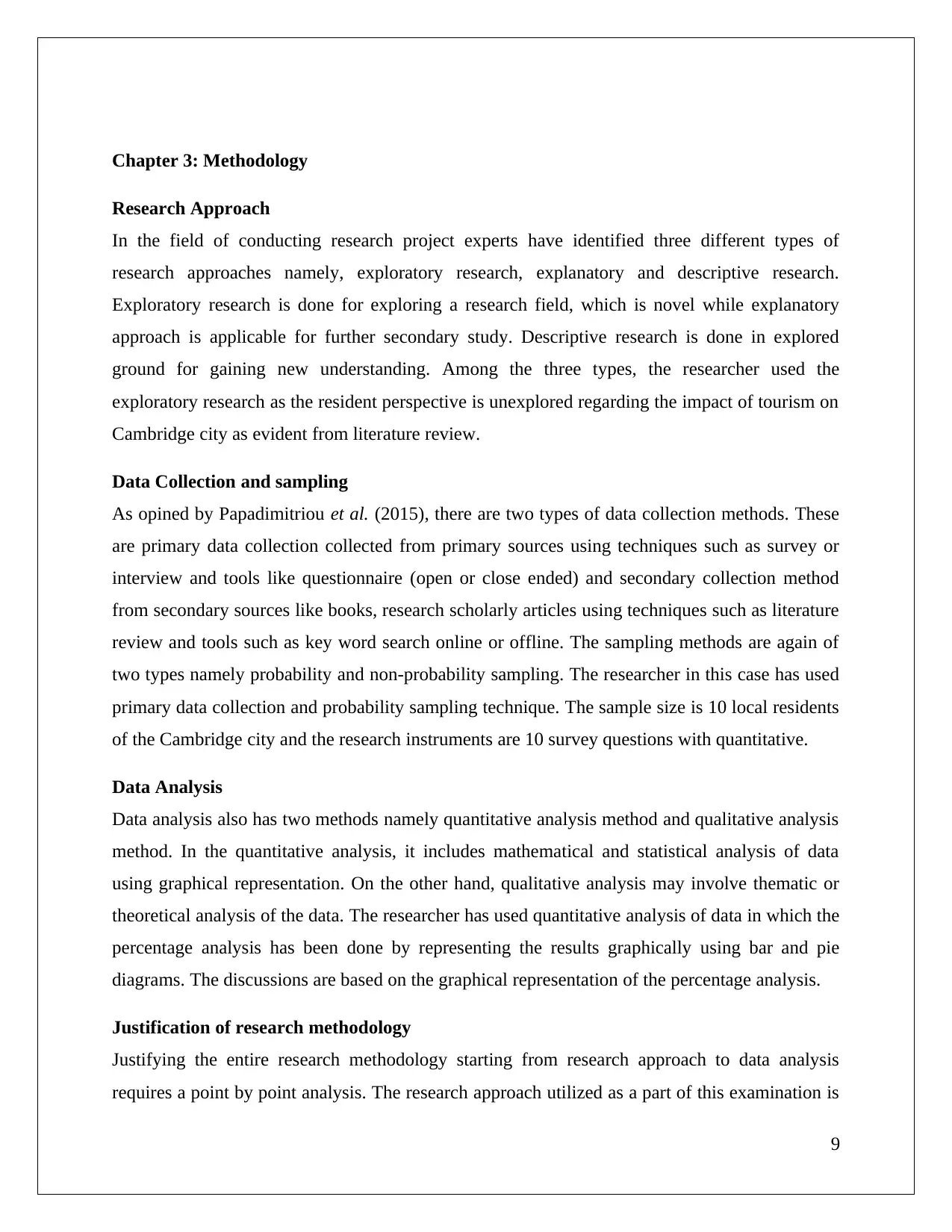
Chapter 3: Methodology
Research Approach
In the field of conducting research project experts have identified three different types of
research approaches namely, exploratory research, explanatory and descriptive research.
Exploratory research is done for exploring a research field, which is novel while explanatory
approach is applicable for further secondary study. Descriptive research is done in explored
ground for gaining new understanding. Among the three types, the researcher used the
exploratory research as the resident perspective is unexplored regarding the impact of tourism on
Cambridge city as evident from literature review.
Data Collection and sampling
As opined by Papadimitriou et al. (2015), there are two types of data collection methods. These
are primary data collection collected from primary sources using techniques such as survey or
interview and tools like questionnaire (open or close ended) and secondary collection method
from secondary sources like books, research scholarly articles using techniques such as literature
review and tools such as key word search online or offline. The sampling methods are again of
two types namely probability and non-probability sampling. The researcher in this case has used
primary data collection and probability sampling technique. The sample size is 10 local residents
of the Cambridge city and the research instruments are 10 survey questions with quantitative.
Data Analysis
Data analysis also has two methods namely quantitative analysis method and qualitative analysis
method. In the quantitative analysis, it includes mathematical and statistical analysis of data
using graphical representation. On the other hand, qualitative analysis may involve thematic or
theoretical analysis of the data. The researcher has used quantitative analysis of data in which the
percentage analysis has been done by representing the results graphically using bar and pie
diagrams. The discussions are based on the graphical representation of the percentage analysis.
Justification of research methodology
Justifying the entire research methodology starting from research approach to data analysis
requires a point by point analysis. The research approach utilized as a part of this examination is
9
Research Approach
In the field of conducting research project experts have identified three different types of
research approaches namely, exploratory research, explanatory and descriptive research.
Exploratory research is done for exploring a research field, which is novel while explanatory
approach is applicable for further secondary study. Descriptive research is done in explored
ground for gaining new understanding. Among the three types, the researcher used the
exploratory research as the resident perspective is unexplored regarding the impact of tourism on
Cambridge city as evident from literature review.
Data Collection and sampling
As opined by Papadimitriou et al. (2015), there are two types of data collection methods. These
are primary data collection collected from primary sources using techniques such as survey or
interview and tools like questionnaire (open or close ended) and secondary collection method
from secondary sources like books, research scholarly articles using techniques such as literature
review and tools such as key word search online or offline. The sampling methods are again of
two types namely probability and non-probability sampling. The researcher in this case has used
primary data collection and probability sampling technique. The sample size is 10 local residents
of the Cambridge city and the research instruments are 10 survey questions with quantitative.
Data Analysis
Data analysis also has two methods namely quantitative analysis method and qualitative analysis
method. In the quantitative analysis, it includes mathematical and statistical analysis of data
using graphical representation. On the other hand, qualitative analysis may involve thematic or
theoretical analysis of the data. The researcher has used quantitative analysis of data in which the
percentage analysis has been done by representing the results graphically using bar and pie
diagrams. The discussions are based on the graphical representation of the percentage analysis.
Justification of research methodology
Justifying the entire research methodology starting from research approach to data analysis
requires a point by point analysis. The research approach utilized as a part of this examination is
9
Paraphrase This Document
Need a fresh take? Get an instant paraphrase of this document with our AI Paraphraser
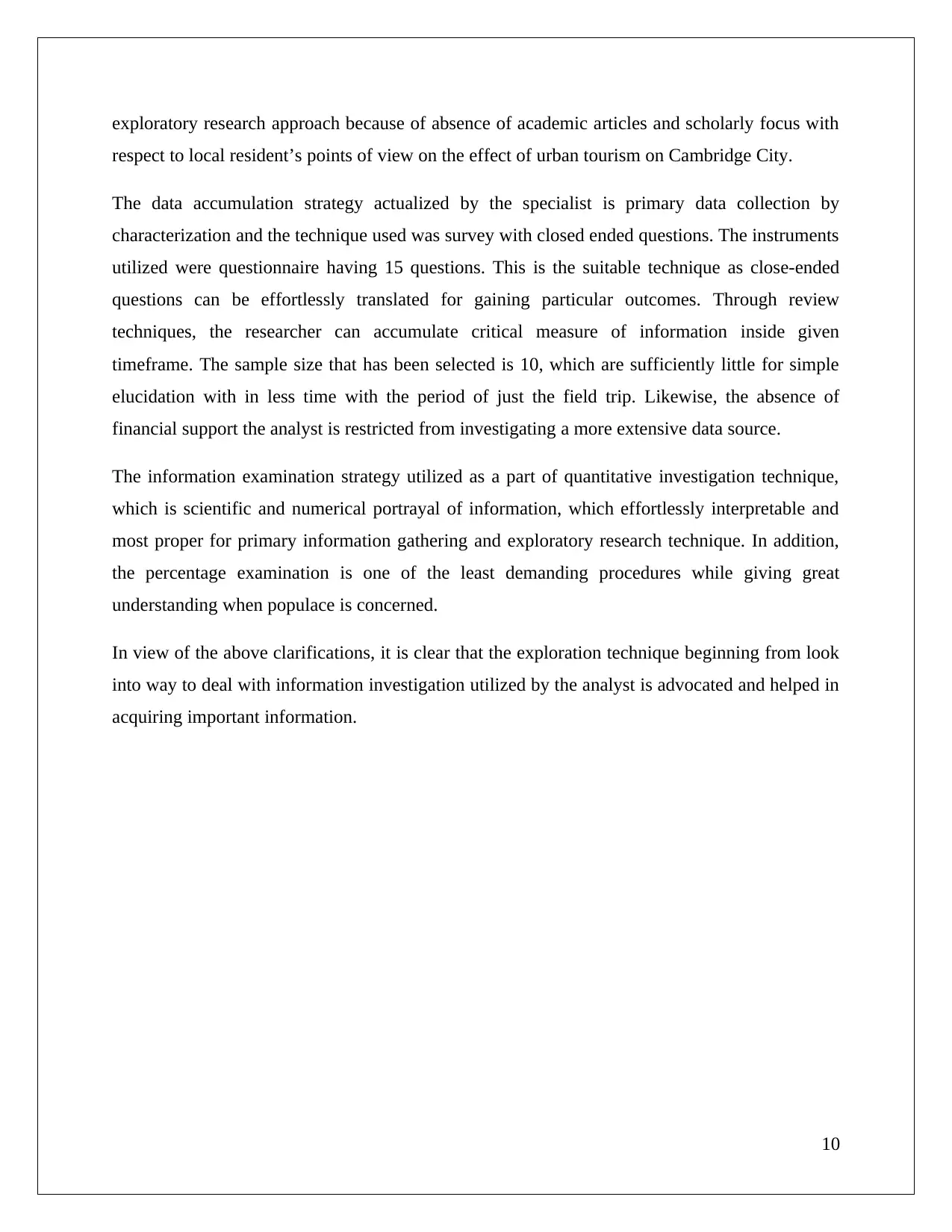
exploratory research approach because of absence of academic articles and scholarly focus with
respect to local resident’s points of view on the effect of urban tourism on Cambridge City.
The data accumulation strategy actualized by the specialist is primary data collection by
characterization and the technique used was survey with closed ended questions. The instruments
utilized were questionnaire having 15 questions. This is the suitable technique as close-ended
questions can be effortlessly translated for gaining particular outcomes. Through review
techniques, the researcher can accumulate critical measure of information inside given
timeframe. The sample size that has been selected is 10, which are sufficiently little for simple
elucidation with in less time with the period of just the field trip. Likewise, the absence of
financial support the analyst is restricted from investigating a more extensive data source.
The information examination strategy utilized as a part of quantitative investigation technique,
which is scientific and numerical portrayal of information, which effortlessly interpretable and
most proper for primary information gathering and exploratory research technique. In addition,
the percentage examination is one of the least demanding procedures while giving great
understanding when populace is concerned.
In view of the above clarifications, it is clear that the exploration technique beginning from look
into way to deal with information investigation utilized by the analyst is advocated and helped in
acquiring important information.
10
respect to local resident’s points of view on the effect of urban tourism on Cambridge City.
The data accumulation strategy actualized by the specialist is primary data collection by
characterization and the technique used was survey with closed ended questions. The instruments
utilized were questionnaire having 15 questions. This is the suitable technique as close-ended
questions can be effortlessly translated for gaining particular outcomes. Through review
techniques, the researcher can accumulate critical measure of information inside given
timeframe. The sample size that has been selected is 10, which are sufficiently little for simple
elucidation with in less time with the period of just the field trip. Likewise, the absence of
financial support the analyst is restricted from investigating a more extensive data source.
The information examination strategy utilized as a part of quantitative investigation technique,
which is scientific and numerical portrayal of information, which effortlessly interpretable and
most proper for primary information gathering and exploratory research technique. In addition,
the percentage examination is one of the least demanding procedures while giving great
understanding when populace is concerned.
In view of the above clarifications, it is clear that the exploration technique beginning from look
into way to deal with information investigation utilized by the analyst is advocated and helped in
acquiring important information.
10
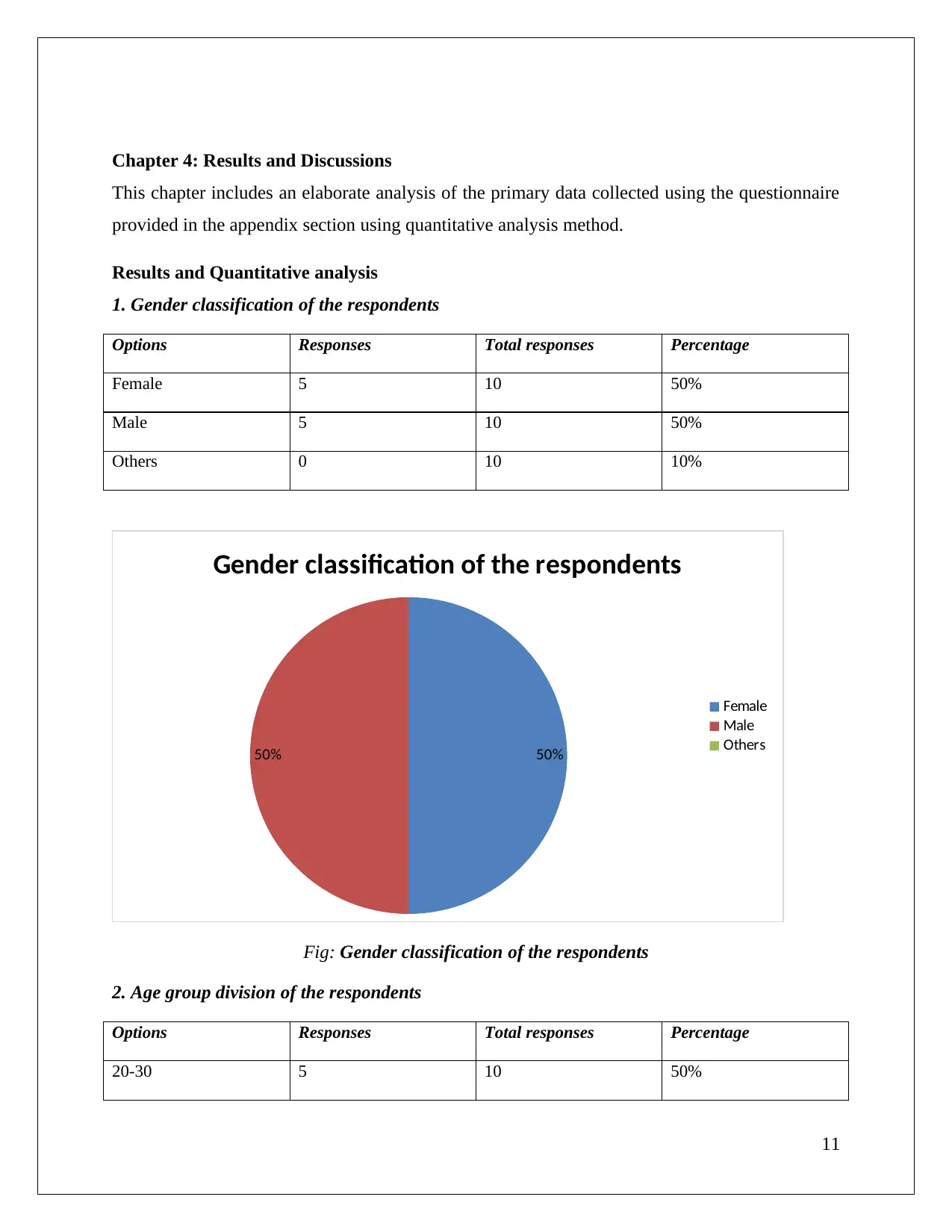
Chapter 4: Results and Discussions
This chapter includes an elaborate analysis of the primary data collected using the questionnaire
provided in the appendix section using quantitative analysis method.
Results and Quantitative analysis
1. Gender classification of the respondents
Options Responses Total responses Percentage
Female 5 10 50%
Male 5 10 50%
Others 0 10 10%
50%50%
Gender classification of the respondents
Female
Male
Others
Fig: Gender classification of the respondents
2. Age group division of the respondents
Options Responses Total responses Percentage
20-30 5 10 50%
11
This chapter includes an elaborate analysis of the primary data collected using the questionnaire
provided in the appendix section using quantitative analysis method.
Results and Quantitative analysis
1. Gender classification of the respondents
Options Responses Total responses Percentage
Female 5 10 50%
Male 5 10 50%
Others 0 10 10%
50%50%
Gender classification of the respondents
Female
Male
Others
Fig: Gender classification of the respondents
2. Age group division of the respondents
Options Responses Total responses Percentage
20-30 5 10 50%
11
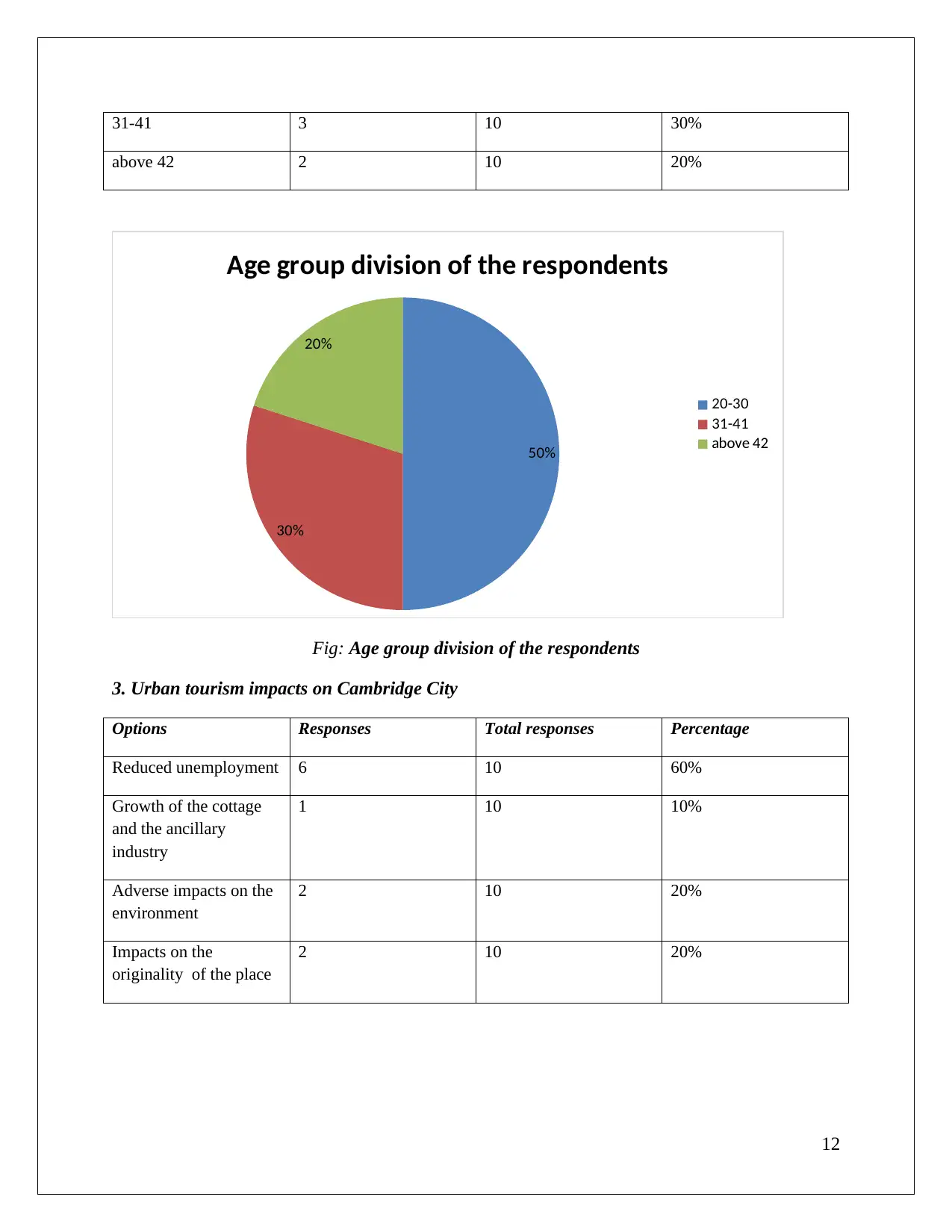
31-41 3 10 30%
above 42 2 10 20%
50%
30%
20%
Age group division of the respondents
20-30
31-41
above 42
Fig: Age group division of the respondents
3. Urban tourism impacts on Cambridge City
Options Responses Total responses Percentage
Reduced unemployment 6 10 60%
Growth of the cottage
and the ancillary
industry
1 10 10%
Adverse impacts on the
environment
2 10 20%
Impacts on the
originality of the place
2 10 20%
12
above 42 2 10 20%
50%
30%
20%
Age group division of the respondents
20-30
31-41
above 42
Fig: Age group division of the respondents
3. Urban tourism impacts on Cambridge City
Options Responses Total responses Percentage
Reduced unemployment 6 10 60%
Growth of the cottage
and the ancillary
industry
1 10 10%
Adverse impacts on the
environment
2 10 20%
Impacts on the
originality of the place
2 10 20%
12
Secure Best Marks with AI Grader
Need help grading? Try our AI Grader for instant feedback on your assignments.

Reduced unemployment Growth of the cottage
and the ancilliary
industry
Adverse impacts on the
environment Impacts on the originality
of the place
60
10
20 20
Urban tourism impacts on Cambridge City
Urban tourism impacts on Cambridge City
Fig: Urban tourism impacts on Cambridge City
4. Urban tourism effects on socio-cultural environment of Cambridge city
Options Responses Total responses Percentage
yes 5 10 50%
no 4 10 40%
may be 1 10 10%
13
and the ancilliary
industry
Adverse impacts on the
environment Impacts on the originality
of the place
60
10
20 20
Urban tourism impacts on Cambridge City
Urban tourism impacts on Cambridge City
Fig: Urban tourism impacts on Cambridge City
4. Urban tourism effects on socio-cultural environment of Cambridge city
Options Responses Total responses Percentage
yes 5 10 50%
no 4 10 40%
may be 1 10 10%
13
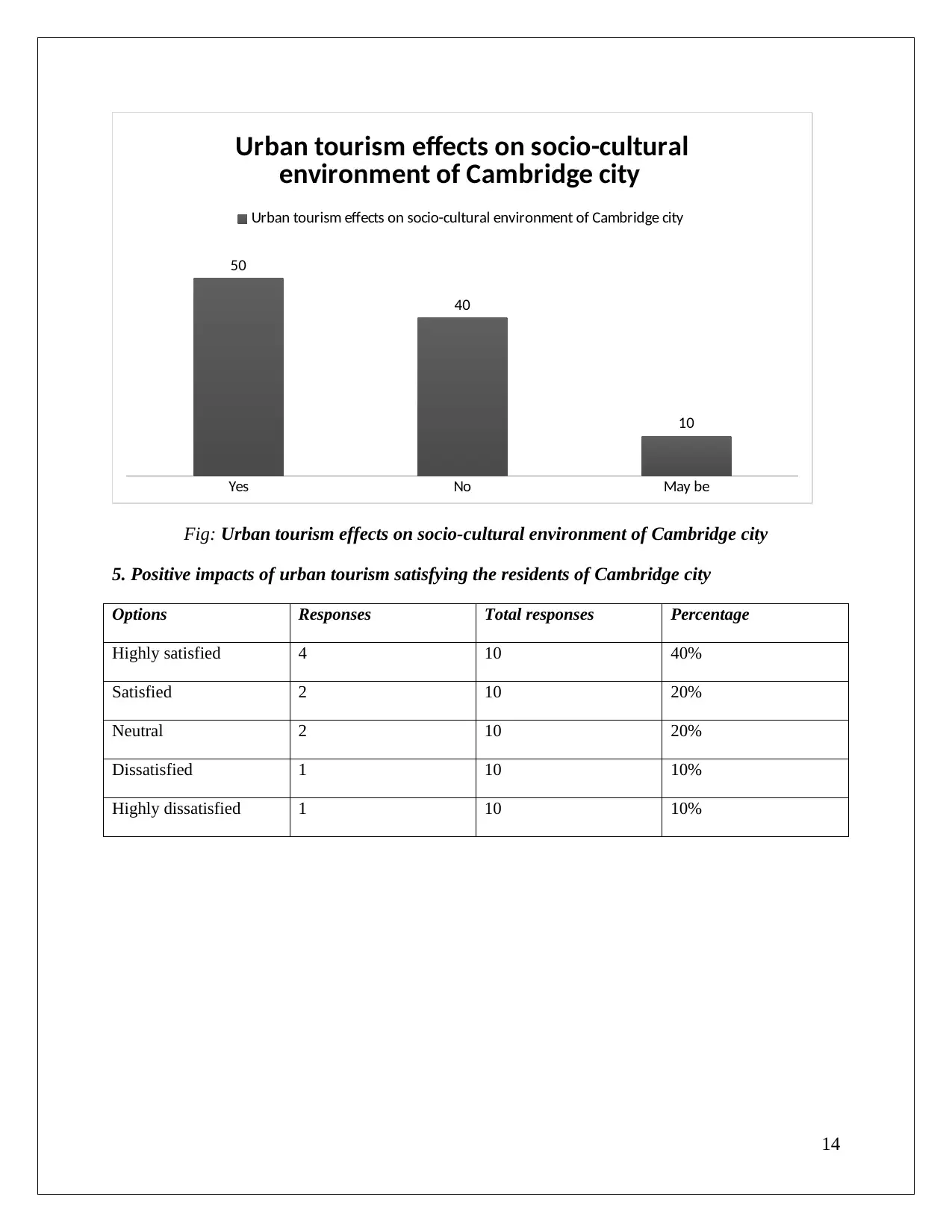
Yes No May be
50
40
10
Urban tourism effects on socio-cultural
environment of Cambridge city
Urban tourism effects on socio-cultural environment of Cambridge city
Fig: Urban tourism effects on socio-cultural environment of Cambridge city
5. Positive impacts of urban tourism satisfying the residents of Cambridge city
Options Responses Total responses Percentage
Highly satisfied 4 10 40%
Satisfied 2 10 20%
Neutral 2 10 20%
Dissatisfied 1 10 10%
Highly dissatisfied 1 10 10%
14
50
40
10
Urban tourism effects on socio-cultural
environment of Cambridge city
Urban tourism effects on socio-cultural environment of Cambridge city
Fig: Urban tourism effects on socio-cultural environment of Cambridge city
5. Positive impacts of urban tourism satisfying the residents of Cambridge city
Options Responses Total responses Percentage
Highly satisfied 4 10 40%
Satisfied 2 10 20%
Neutral 2 10 20%
Dissatisfied 1 10 10%
Highly dissatisfied 1 10 10%
14
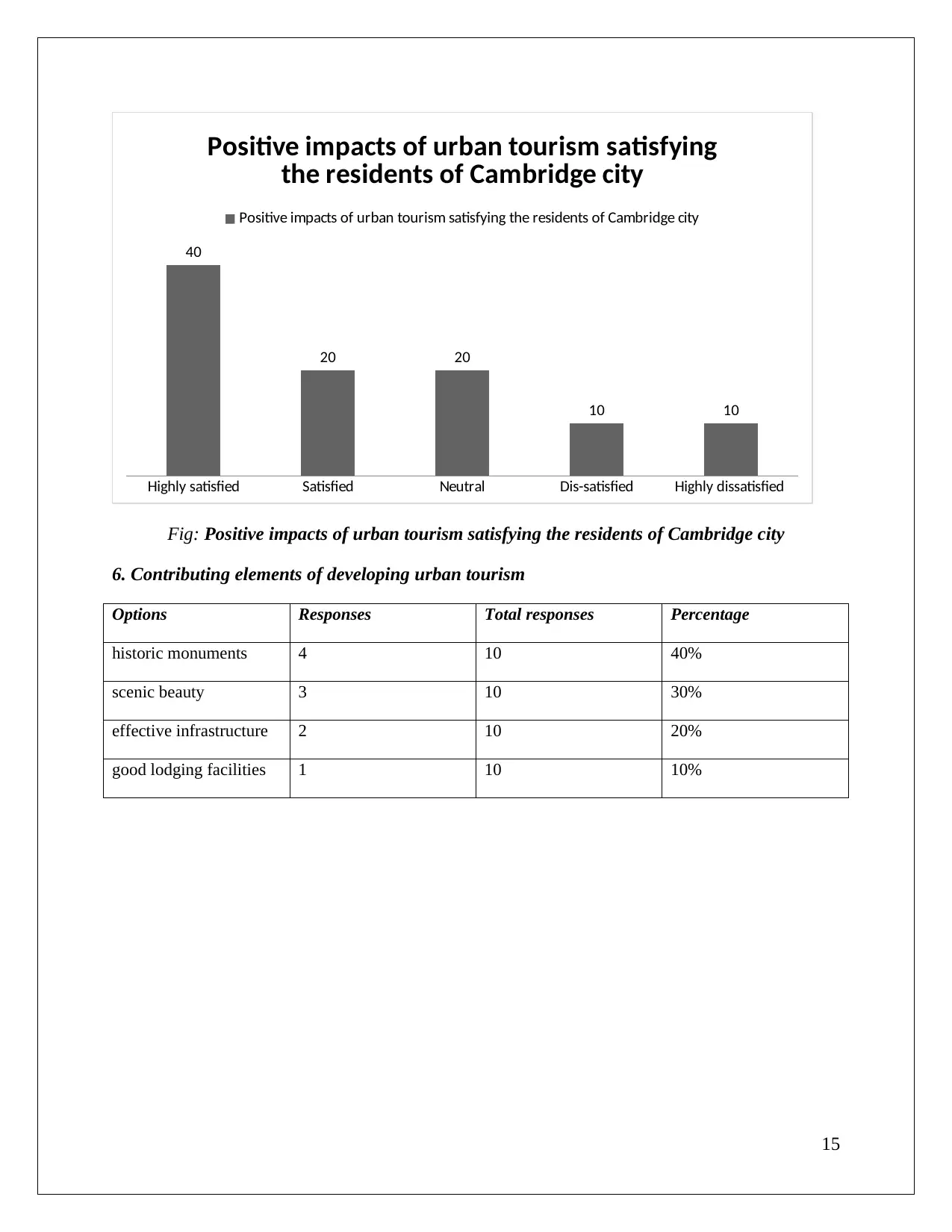
Highly satisfied Satisfied Neutral Dis-satisfied Highly dissatisfied
40
20 20
10 10
Positive impacts of urban tourism satisfying
the residents of Cambridge city
Positive impacts of urban tourism satisfying the residents of Cambridge city
Fig: Positive impacts of urban tourism satisfying the residents of Cambridge city
6. Contributing elements of developing urban tourism
Options Responses Total responses Percentage
historic monuments 4 10 40%
scenic beauty 3 10 30%
effective infrastructure 2 10 20%
good lodging facilities 1 10 10%
15
40
20 20
10 10
Positive impacts of urban tourism satisfying
the residents of Cambridge city
Positive impacts of urban tourism satisfying the residents of Cambridge city
Fig: Positive impacts of urban tourism satisfying the residents of Cambridge city
6. Contributing elements of developing urban tourism
Options Responses Total responses Percentage
historic monuments 4 10 40%
scenic beauty 3 10 30%
effective infrastructure 2 10 20%
good lodging facilities 1 10 10%
15
Paraphrase This Document
Need a fresh take? Get an instant paraphrase of this document with our AI Paraphraser
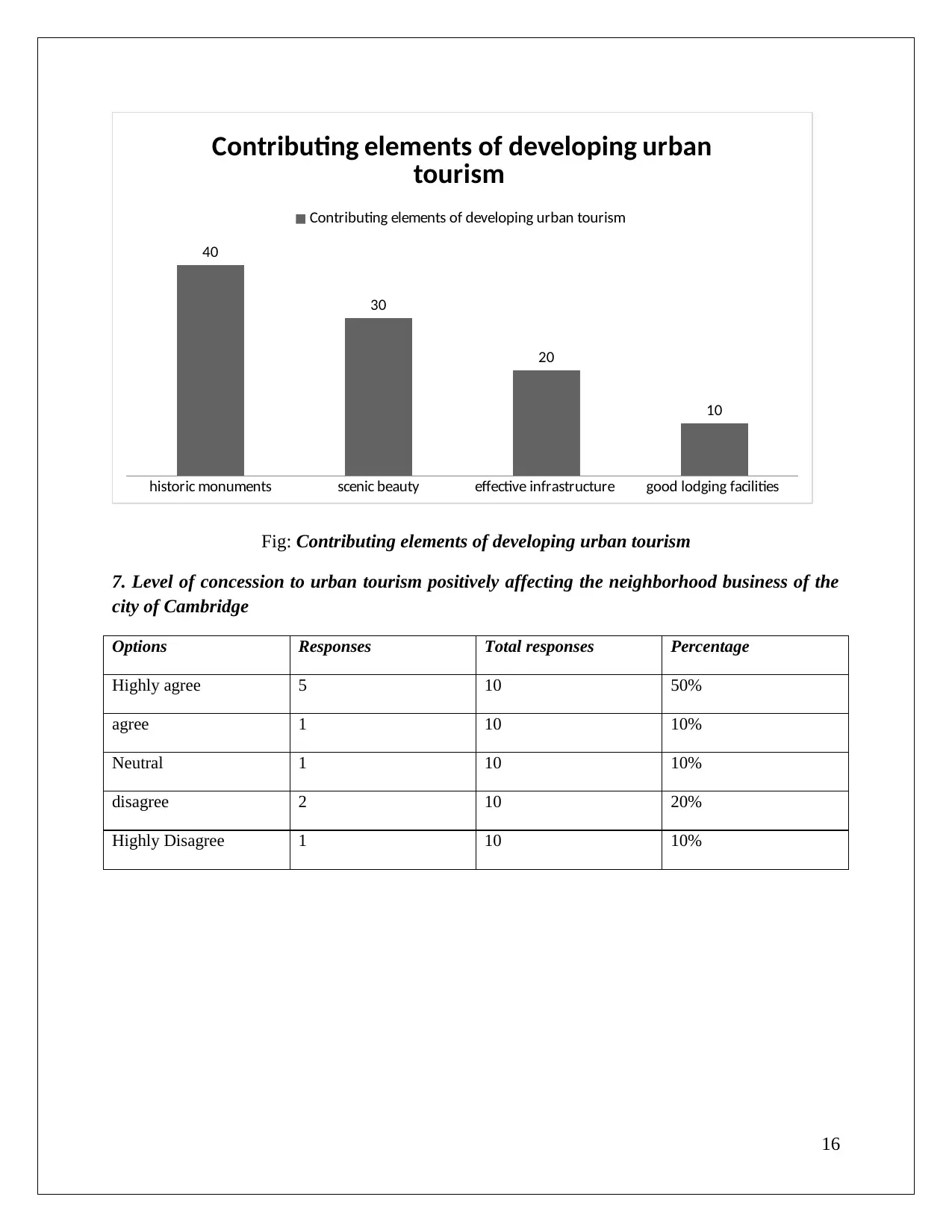
historic monuments scenic beauty effective infrastructure good lodging facilities
40
30
20
10
Contributing elements of developing urban
tourism
Contributing elements of developing urban tourism
Fig: Contributing elements of developing urban tourism
7. Level of concession to urban tourism positively affecting the neighborhood business of the
city of Cambridge
Options Responses Total responses Percentage
Highly agree 5 10 50%
agree 1 10 10%
Neutral 1 10 10%
disagree 2 10 20%
Highly Disagree 1 10 10%
16
40
30
20
10
Contributing elements of developing urban
tourism
Contributing elements of developing urban tourism
Fig: Contributing elements of developing urban tourism
7. Level of concession to urban tourism positively affecting the neighborhood business of the
city of Cambridge
Options Responses Total responses Percentage
Highly agree 5 10 50%
agree 1 10 10%
Neutral 1 10 10%
disagree 2 10 20%
Highly Disagree 1 10 10%
16
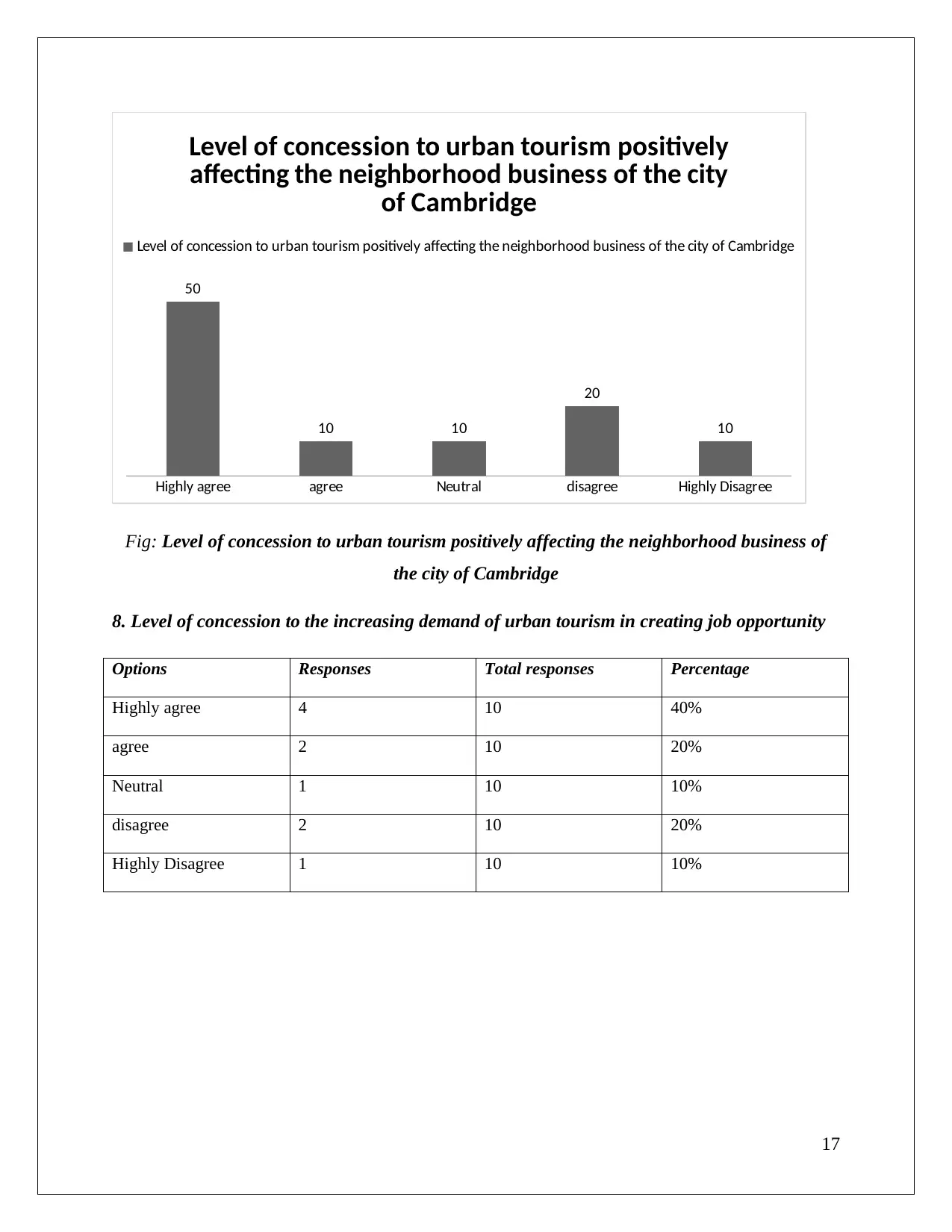
Highly agree agree Neutral disagree Highly Disagree
50
10 10
20
10
Level of concession to urban tourism positively
affecting the neighborhood business of the city
of Cambridge
Level of concession to urban tourism positively affecting the neighborhood business of the city of Cambridge
Fig: Level of concession to urban tourism positively affecting the neighborhood business of
the city of Cambridge
8. Level of concession to the increasing demand of urban tourism in creating job opportunity
Options Responses Total responses Percentage
Highly agree 4 10 40%
agree 2 10 20%
Neutral 1 10 10%
disagree 2 10 20%
Highly Disagree 1 10 10%
17
50
10 10
20
10
Level of concession to urban tourism positively
affecting the neighborhood business of the city
of Cambridge
Level of concession to urban tourism positively affecting the neighborhood business of the city of Cambridge
Fig: Level of concession to urban tourism positively affecting the neighborhood business of
the city of Cambridge
8. Level of concession to the increasing demand of urban tourism in creating job opportunity
Options Responses Total responses Percentage
Highly agree 4 10 40%
agree 2 10 20%
Neutral 1 10 10%
disagree 2 10 20%
Highly Disagree 1 10 10%
17
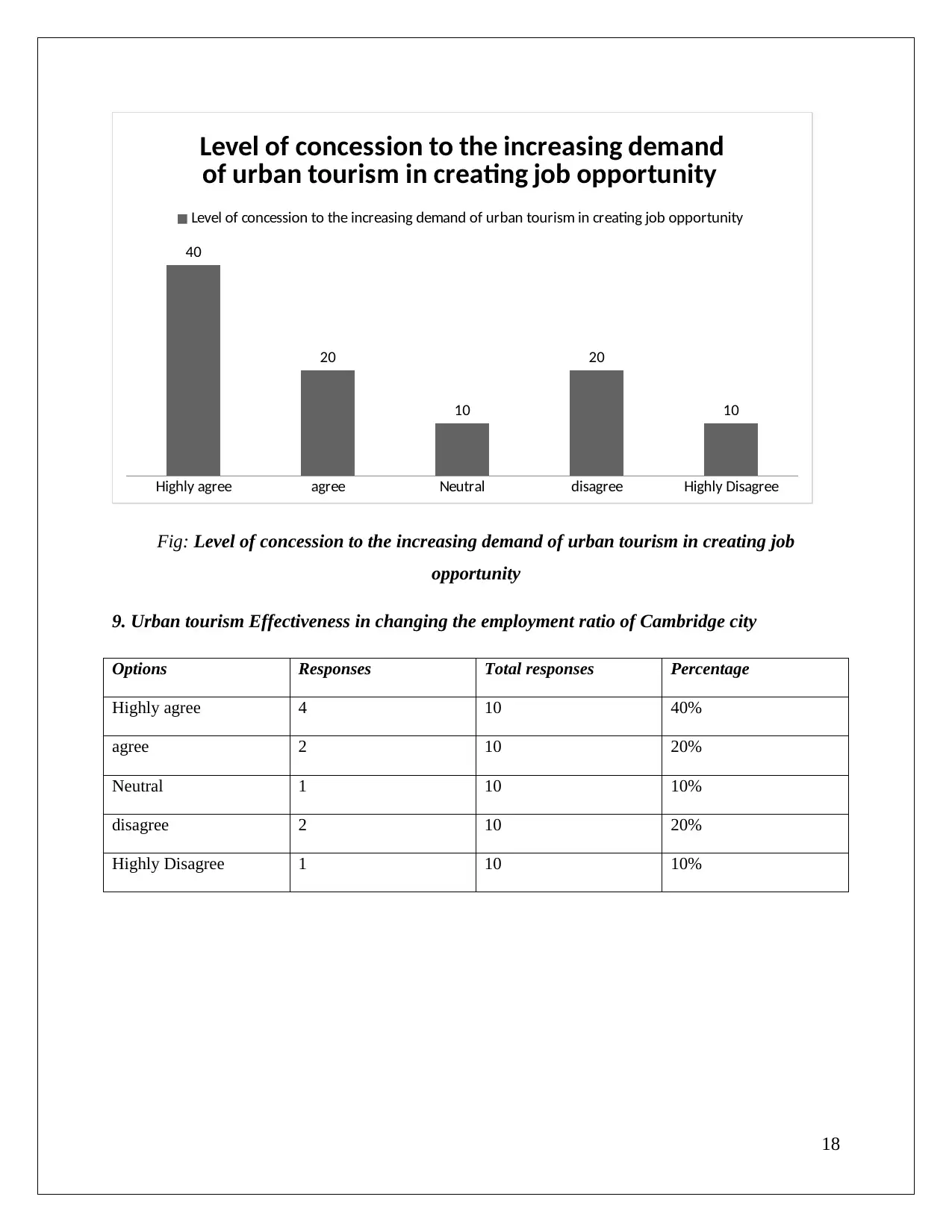
Highly agree agree Neutral disagree Highly Disagree
40
20
10
20
10
Level of concession to the increasing demand
of urban tourism in creating job opportunity
Level of concession to the increasing demand of urban tourism in creating job opportunity
Fig: Level of concession to the increasing demand of urban tourism in creating job
opportunity
9. Urban tourism Effectiveness in changing the employment ratio of Cambridge city
Options Responses Total responses Percentage
Highly agree 4 10 40%
agree 2 10 20%
Neutral 1 10 10%
disagree 2 10 20%
Highly Disagree 1 10 10%
18
40
20
10
20
10
Level of concession to the increasing demand
of urban tourism in creating job opportunity
Level of concession to the increasing demand of urban tourism in creating job opportunity
Fig: Level of concession to the increasing demand of urban tourism in creating job
opportunity
9. Urban tourism Effectiveness in changing the employment ratio of Cambridge city
Options Responses Total responses Percentage
Highly agree 4 10 40%
agree 2 10 20%
Neutral 1 10 10%
disagree 2 10 20%
Highly Disagree 1 10 10%
18
Secure Best Marks with AI Grader
Need help grading? Try our AI Grader for instant feedback on your assignments.

Highly agree agree Neutral disagree Highly Disagree
40
20
10
20
10
Urban tourism Effectiveness in changing the
employment ratio of Cambridge city
Urban tourism Effectiveness in changing the employment ratio of Cambridge city
Fig: Urban tourism Effectiveness in changing the employment ratio of Cambridge city
10. Increasing Urban Tourism activity effecting the natural environment of Cambridge
Options Responses Total responses Percentage
Yes 4 10 40%
No 3 10 30%
may be 3 10 30%
19
40
20
10
20
10
Urban tourism Effectiveness in changing the
employment ratio of Cambridge city
Urban tourism Effectiveness in changing the employment ratio of Cambridge city
Fig: Urban tourism Effectiveness in changing the employment ratio of Cambridge city
10. Increasing Urban Tourism activity effecting the natural environment of Cambridge
Options Responses Total responses Percentage
Yes 4 10 40%
No 3 10 30%
may be 3 10 30%
19
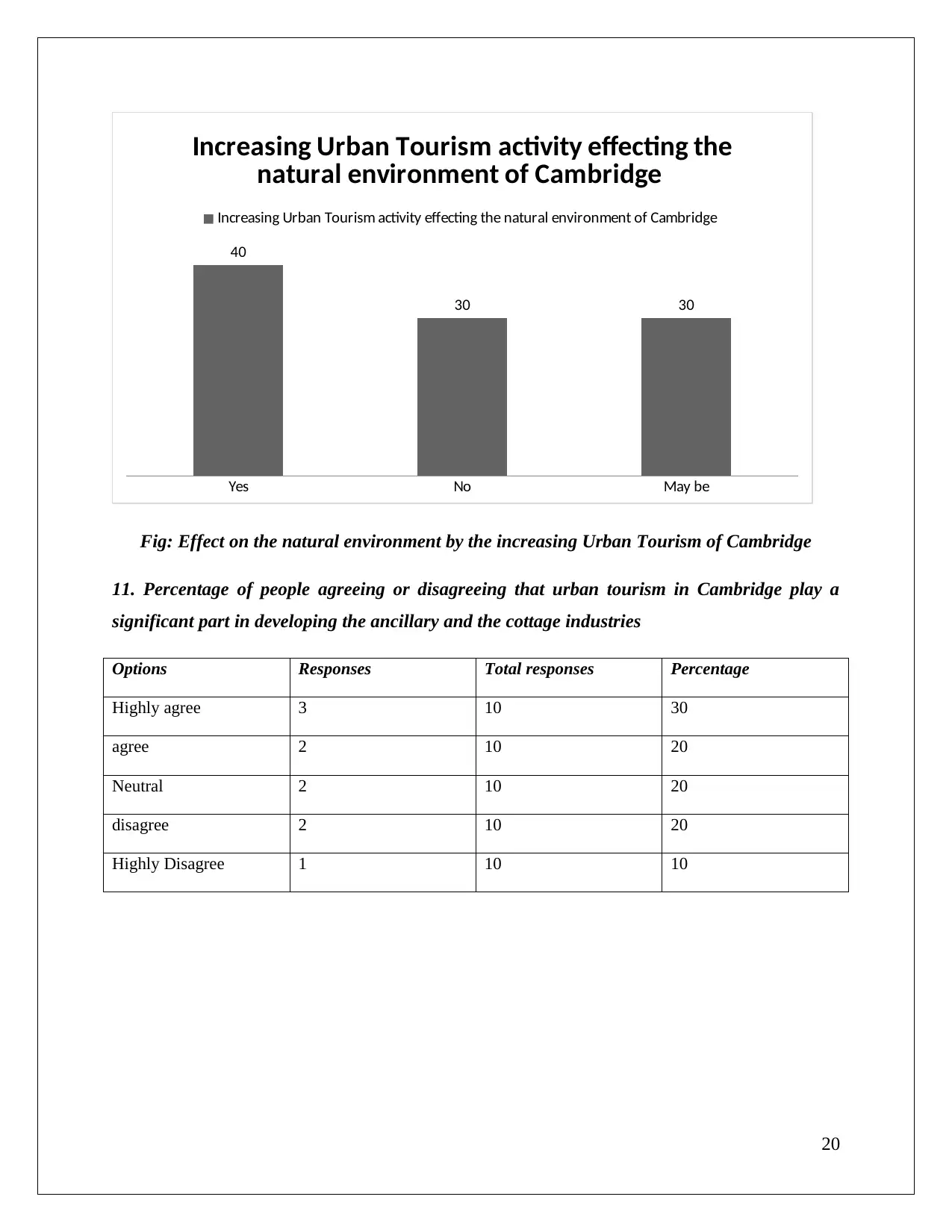
Yes No May be
40
30 30
Increasing Urban Tourism activity effecting the
natural environment of Cambridge
Increasing Urban Tourism activity effecting the natural environment of Cambridge
Fig: Effect on the natural environment by the increasing Urban Tourism of Cambridge
11. Percentage of people agreeing or disagreeing that urban tourism in Cambridge play a
significant part in developing the ancillary and the cottage industries
Options Responses Total responses Percentage
Highly agree 3 10 30
agree 2 10 20
Neutral 2 10 20
disagree 2 10 20
Highly Disagree 1 10 10
20
40
30 30
Increasing Urban Tourism activity effecting the
natural environment of Cambridge
Increasing Urban Tourism activity effecting the natural environment of Cambridge
Fig: Effect on the natural environment by the increasing Urban Tourism of Cambridge
11. Percentage of people agreeing or disagreeing that urban tourism in Cambridge play a
significant part in developing the ancillary and the cottage industries
Options Responses Total responses Percentage
Highly agree 3 10 30
agree 2 10 20
Neutral 2 10 20
disagree 2 10 20
Highly Disagree 1 10 10
20
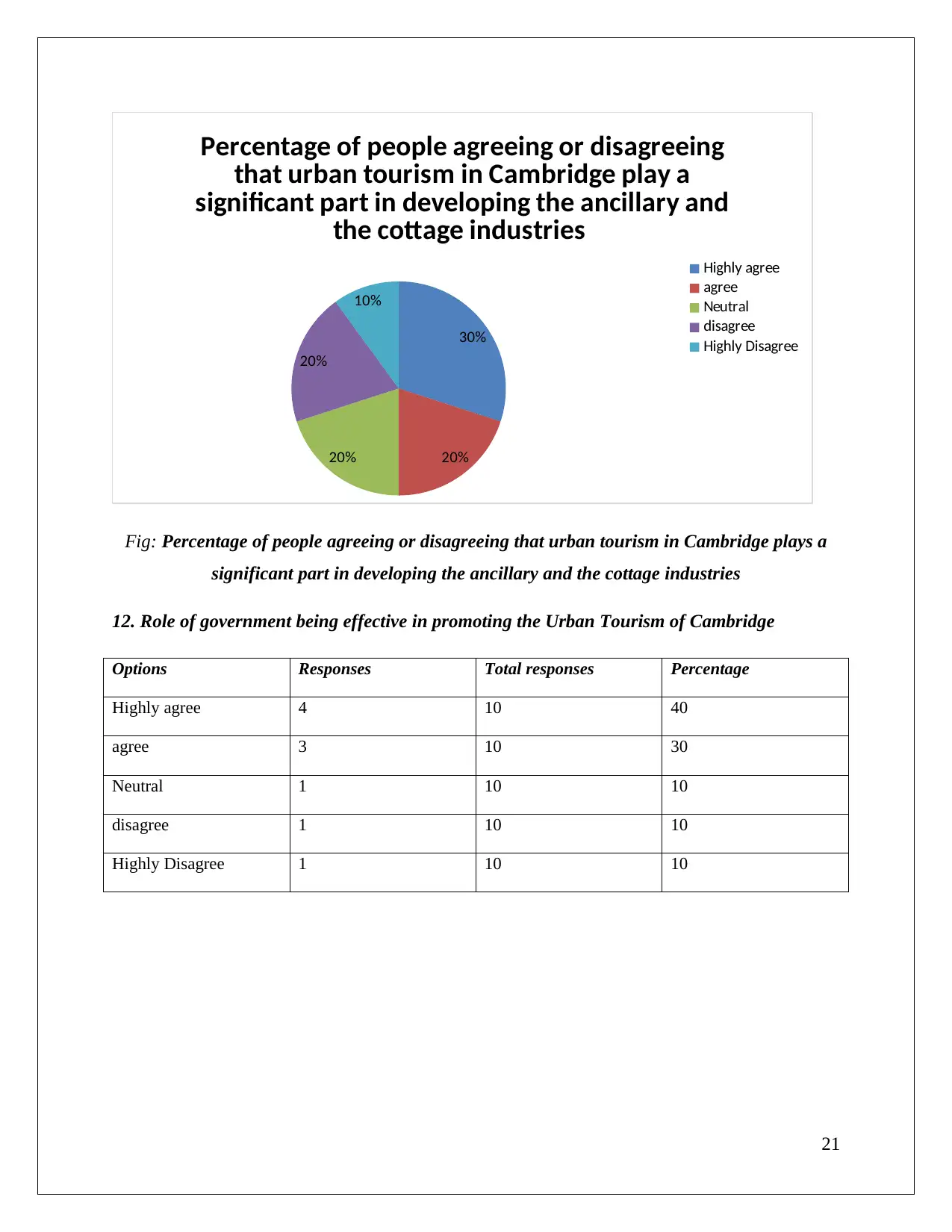
30%
20%20%
20%
10%
Percentage of people agreeing or disagreeing
that urban tourism in Cambridge play a
significant part in developing the ancillary and
the cottage industries
Highly agree
agree
Neutral
disagree
Highly Disagree
Fig: Percentage of people agreeing or disagreeing that urban tourism in Cambridge plays a
significant part in developing the ancillary and the cottage industries
12. Role of government being effective in promoting the Urban Tourism of Cambridge
Options Responses Total responses Percentage
Highly agree 4 10 40
agree 3 10 30
Neutral 1 10 10
disagree 1 10 10
Highly Disagree 1 10 10
21
20%20%
20%
10%
Percentage of people agreeing or disagreeing
that urban tourism in Cambridge play a
significant part in developing the ancillary and
the cottage industries
Highly agree
agree
Neutral
disagree
Highly Disagree
Fig: Percentage of people agreeing or disagreeing that urban tourism in Cambridge plays a
significant part in developing the ancillary and the cottage industries
12. Role of government being effective in promoting the Urban Tourism of Cambridge
Options Responses Total responses Percentage
Highly agree 4 10 40
agree 3 10 30
Neutral 1 10 10
disagree 1 10 10
Highly Disagree 1 10 10
21
Paraphrase This Document
Need a fresh take? Get an instant paraphrase of this document with our AI Paraphraser
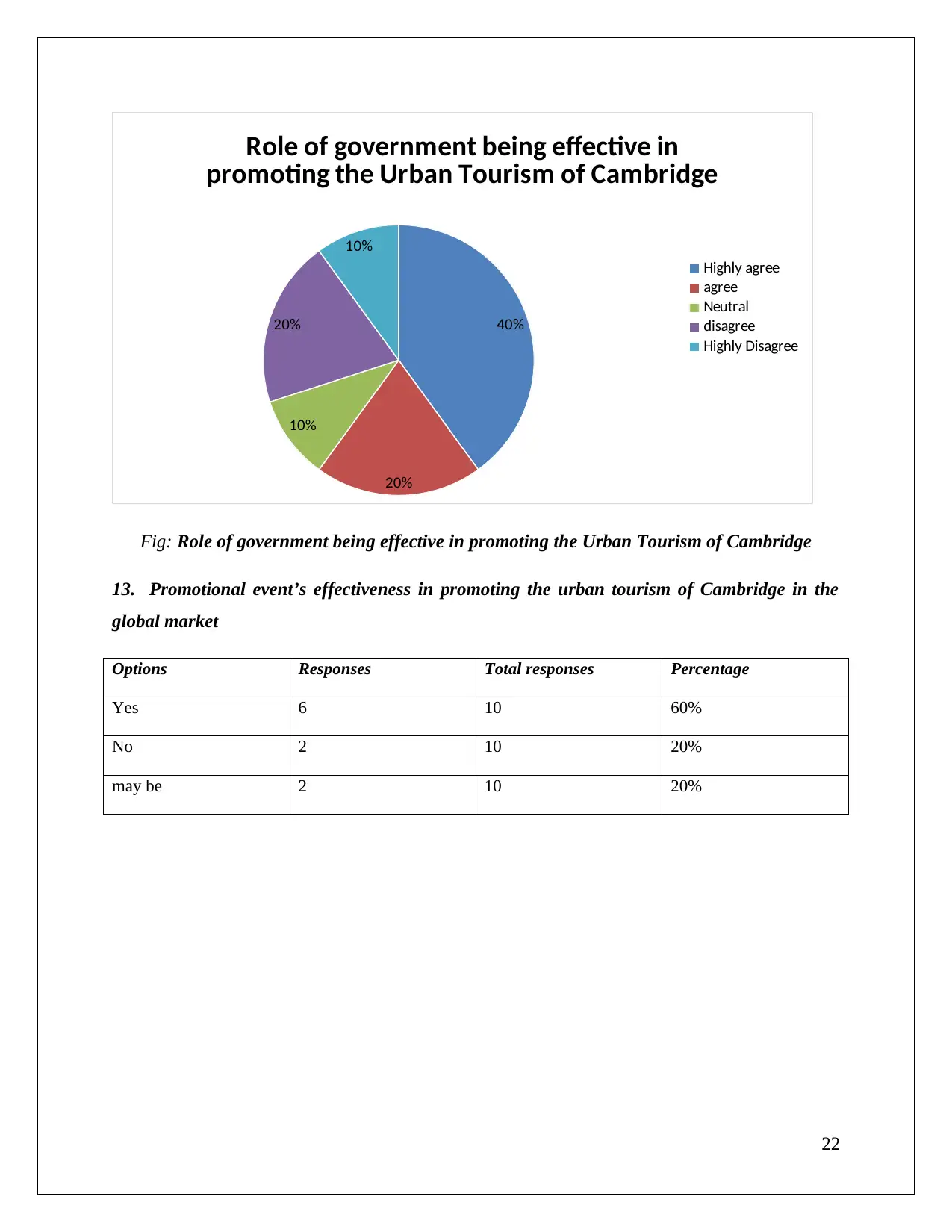
40%
20%
10%
20%
10%
Role of government being effective in
promoting the Urban Tourism of Cambridge
Highly agree
agree
Neutral
disagree
Highly Disagree
Fig: Role of government being effective in promoting the Urban Tourism of Cambridge
13. Promotional event’s effectiveness in promoting the urban tourism of Cambridge in the
global market
Options Responses Total responses Percentage
Yes 6 10 60%
No 2 10 20%
may be 2 10 20%
22
20%
10%
20%
10%
Role of government being effective in
promoting the Urban Tourism of Cambridge
Highly agree
agree
Neutral
disagree
Highly Disagree
Fig: Role of government being effective in promoting the Urban Tourism of Cambridge
13. Promotional event’s effectiveness in promoting the urban tourism of Cambridge in the
global market
Options Responses Total responses Percentage
Yes 6 10 60%
No 2 10 20%
may be 2 10 20%
22
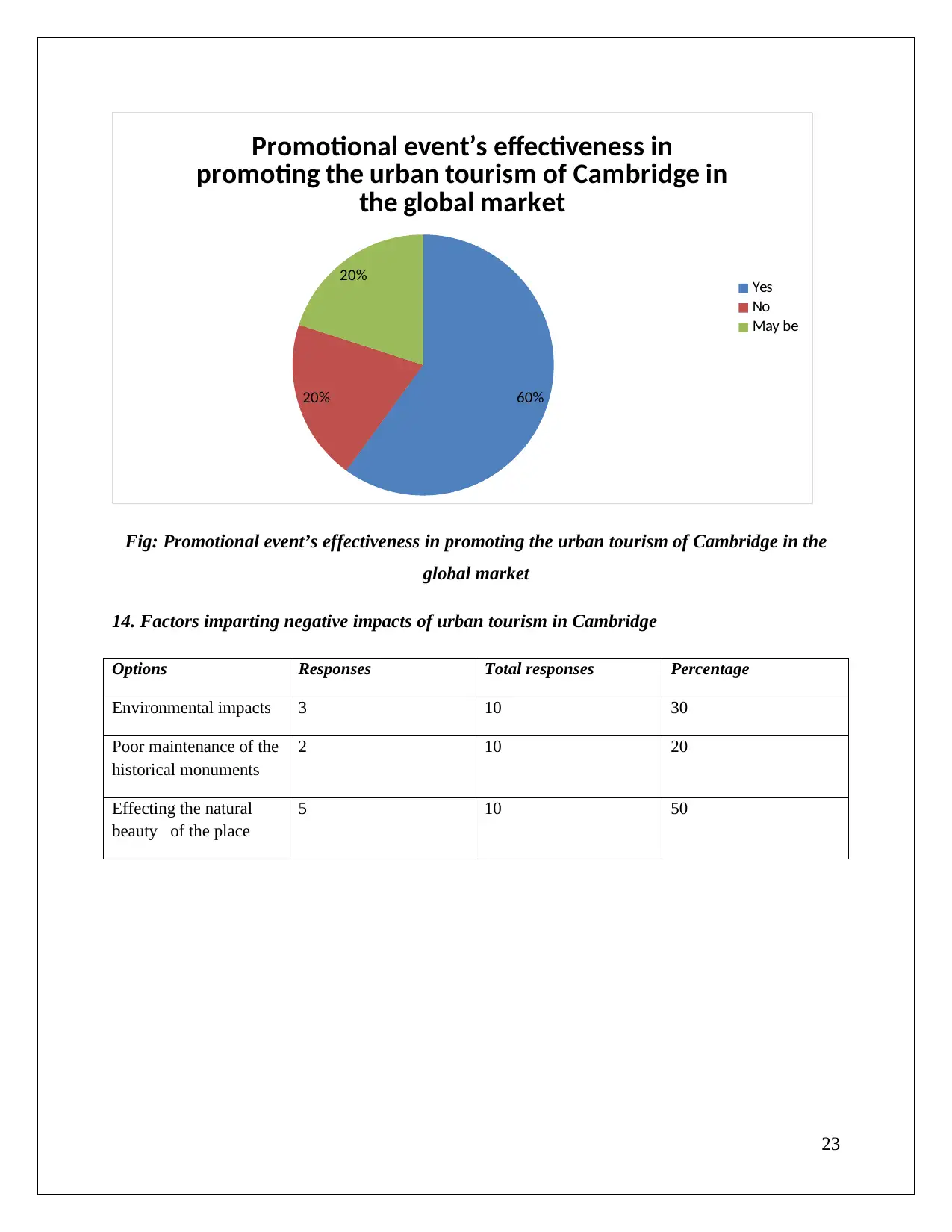
60%20%
20%
Promotional event’s effectiveness in
promoting the urban tourism of Cambridge in
the global market
Yes
No
May be
Fig: Promotional event’s effectiveness in promoting the urban tourism of Cambridge in the
global market
14. Factors imparting negative impacts of urban tourism in Cambridge
Options Responses Total responses Percentage
Environmental impacts 3 10 30
Poor maintenance of the
historical monuments
2 10 20
Effecting the natural
beauty of the place
5 10 50
23
20%
Promotional event’s effectiveness in
promoting the urban tourism of Cambridge in
the global market
Yes
No
May be
Fig: Promotional event’s effectiveness in promoting the urban tourism of Cambridge in the
global market
14. Factors imparting negative impacts of urban tourism in Cambridge
Options Responses Total responses Percentage
Environmental impacts 3 10 30
Poor maintenance of the
historical monuments
2 10 20
Effecting the natural
beauty of the place
5 10 50
23
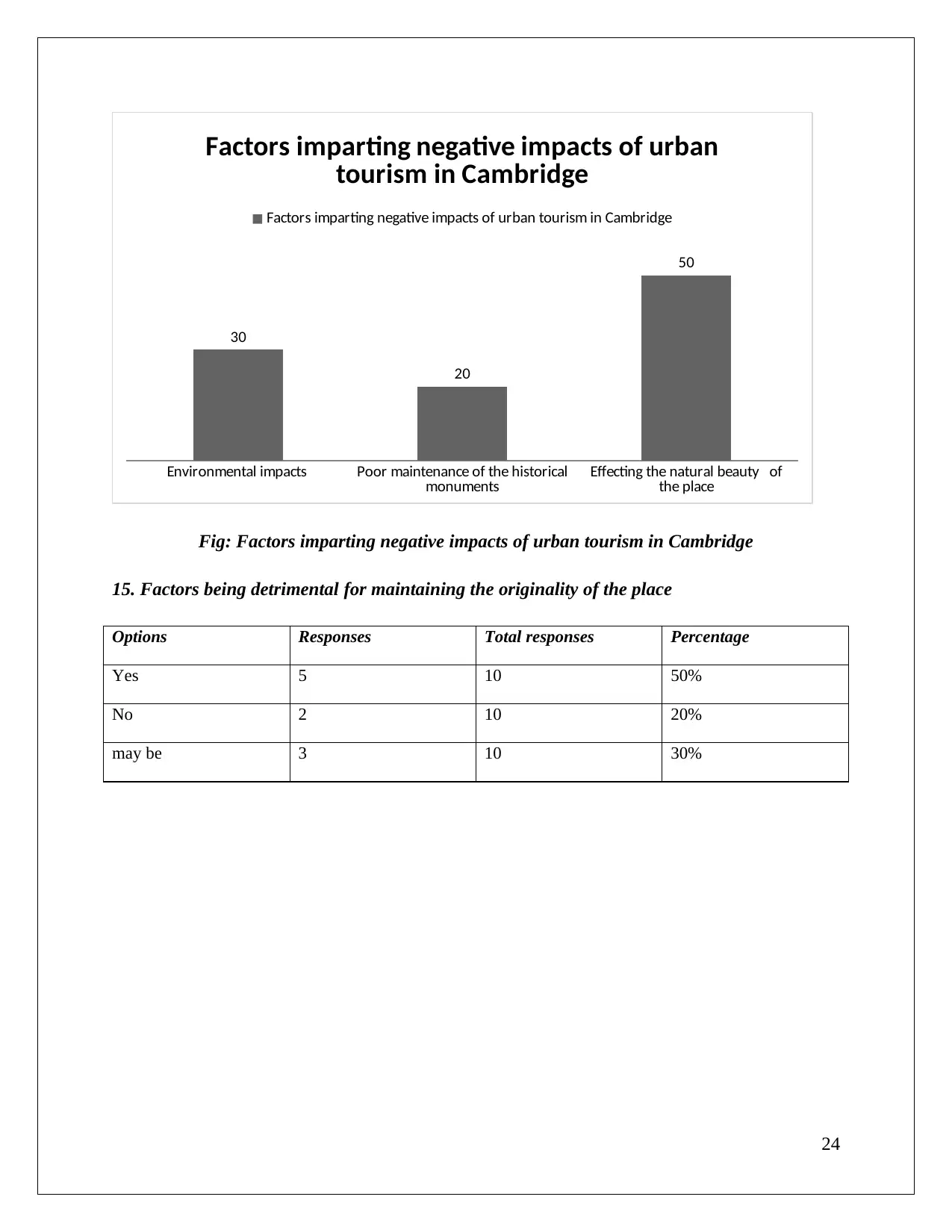
Environmental impacts Poor maintenance of the historical
monuments Effecting the natural beauty of
the place
30
20
50
Factors imparting negative impacts of urban
tourism in Cambridge
Factors imparting negative impacts of urban tourism in Cambridge
Fig: Factors imparting negative impacts of urban tourism in Cambridge
15. Factors being detrimental for maintaining the originality of the place
Options Responses Total responses Percentage
Yes 5 10 50%
No 2 10 20%
may be 3 10 30%
24
monuments Effecting the natural beauty of
the place
30
20
50
Factors imparting negative impacts of urban
tourism in Cambridge
Factors imparting negative impacts of urban tourism in Cambridge
Fig: Factors imparting negative impacts of urban tourism in Cambridge
15. Factors being detrimental for maintaining the originality of the place
Options Responses Total responses Percentage
Yes 5 10 50%
No 2 10 20%
may be 3 10 30%
24
Secure Best Marks with AI Grader
Need help grading? Try our AI Grader for instant feedback on your assignments.
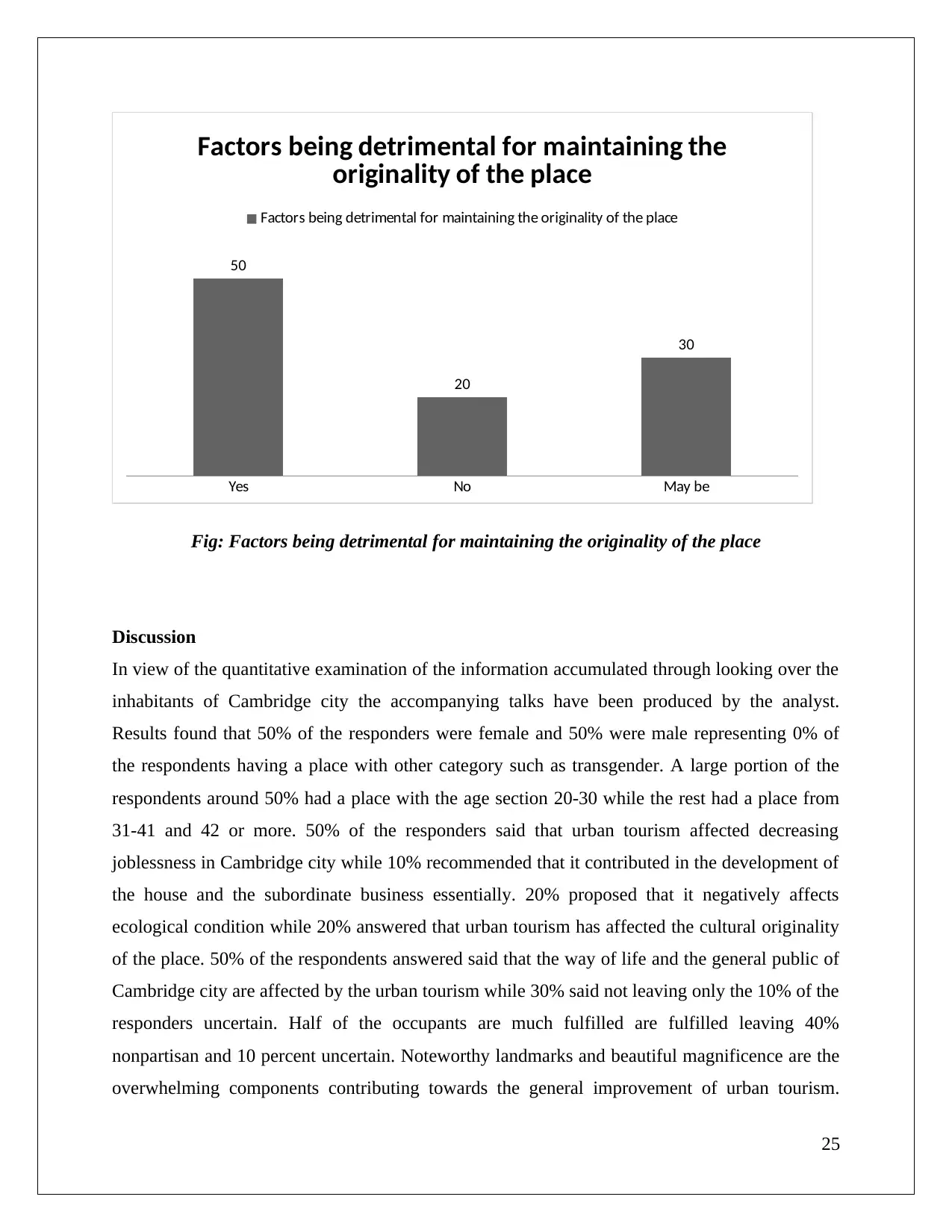
Yes No May be
50
20
30
Factors being detrimental for maintaining the
originality of the place
Factors being detrimental for maintaining the originality of the place
Fig: Factors being detrimental for maintaining the originality of the place
Discussion
In view of the quantitative examination of the information accumulated through looking over the
inhabitants of Cambridge city the accompanying talks have been produced by the analyst.
Results found that 50% of the responders were female and 50% were male representing 0% of
the respondents having a place with other category such as transgender. A large portion of the
respondents around 50% had a place with the age section 20-30 while the rest had a place from
31-41 and 42 or more. 50% of the responders said that urban tourism affected decreasing
joblessness in Cambridge city while 10% recommended that it contributed in the development of
the house and the subordinate business essentially. 20% proposed that it negatively affects
ecological condition while 20% answered that urban tourism has affected the cultural originality
of the place. 50% of the respondents answered said that the way of life and the general public of
Cambridge city are affected by the urban tourism while 30% said not leaving only the 10% of the
responders uncertain. Half of the occupants are much fulfilled are fulfilled leaving 40%
nonpartisan and 10 percent uncertain. Noteworthy landmarks and beautiful magnificence are the
overwhelming components contributing towards the general improvement of urban tourism.
25
50
20
30
Factors being detrimental for maintaining the
originality of the place
Factors being detrimental for maintaining the originality of the place
Fig: Factors being detrimental for maintaining the originality of the place
Discussion
In view of the quantitative examination of the information accumulated through looking over the
inhabitants of Cambridge city the accompanying talks have been produced by the analyst.
Results found that 50% of the responders were female and 50% were male representing 0% of
the respondents having a place with other category such as transgender. A large portion of the
respondents around 50% had a place with the age section 20-30 while the rest had a place from
31-41 and 42 or more. 50% of the responders said that urban tourism affected decreasing
joblessness in Cambridge city while 10% recommended that it contributed in the development of
the house and the subordinate business essentially. 20% proposed that it negatively affects
ecological condition while 20% answered that urban tourism has affected the cultural originality
of the place. 50% of the respondents answered said that the way of life and the general public of
Cambridge city are affected by the urban tourism while 30% said not leaving only the 10% of the
responders uncertain. Half of the occupants are much fulfilled are fulfilled leaving 40%
nonpartisan and 10 percent uncertain. Noteworthy landmarks and beautiful magnificence are the
overwhelming components contributing towards the general improvement of urban tourism.
25

Greater part of the occupants concur that urban tourism positively affects the neighborhood
business of the notable city of Cambridge and expanding interest of urban tourism in making
opening for work for the inhabitants of Cambridge city. They have additionally concurred that
urban tourism has gotten exceptional changes the business proportion of the place. Nonetheless,
they additionally concurred that urban tourism has influenced the regular habitat yet decidedly
contributed in assuming an essential part in building up the auxiliary and the house businesses of
the place. 70% addressed decidedly towards government's part in advancing the Urban Tourism
of Cambridge and that the limited time occasions are without a doubt successful. Ecological
effects and influencing the normal excellence of the place are the real negative effects of urban
tourism on Cambridge city and these elements are averse to keep up the creativity of the place.
These results suggest that urban tourism has an overall positive effect while few of the negative
effects are persisting according to the resident’s perspectives. Consequently, the negative effects
are becoming a matter of concern because these are influencing the ecological and socio-cultural
environment of the city despite the huge contributions in employment generation.
26
business of the notable city of Cambridge and expanding interest of urban tourism in making
opening for work for the inhabitants of Cambridge city. They have additionally concurred that
urban tourism has gotten exceptional changes the business proportion of the place. Nonetheless,
they additionally concurred that urban tourism has influenced the regular habitat yet decidedly
contributed in assuming an essential part in building up the auxiliary and the house businesses of
the place. 70% addressed decidedly towards government's part in advancing the Urban Tourism
of Cambridge and that the limited time occasions are without a doubt successful. Ecological
effects and influencing the normal excellence of the place are the real negative effects of urban
tourism on Cambridge city and these elements are averse to keep up the creativity of the place.
These results suggest that urban tourism has an overall positive effect while few of the negative
effects are persisting according to the resident’s perspectives. Consequently, the negative effects
are becoming a matter of concern because these are influencing the ecological and socio-cultural
environment of the city despite the huge contributions in employment generation.
26
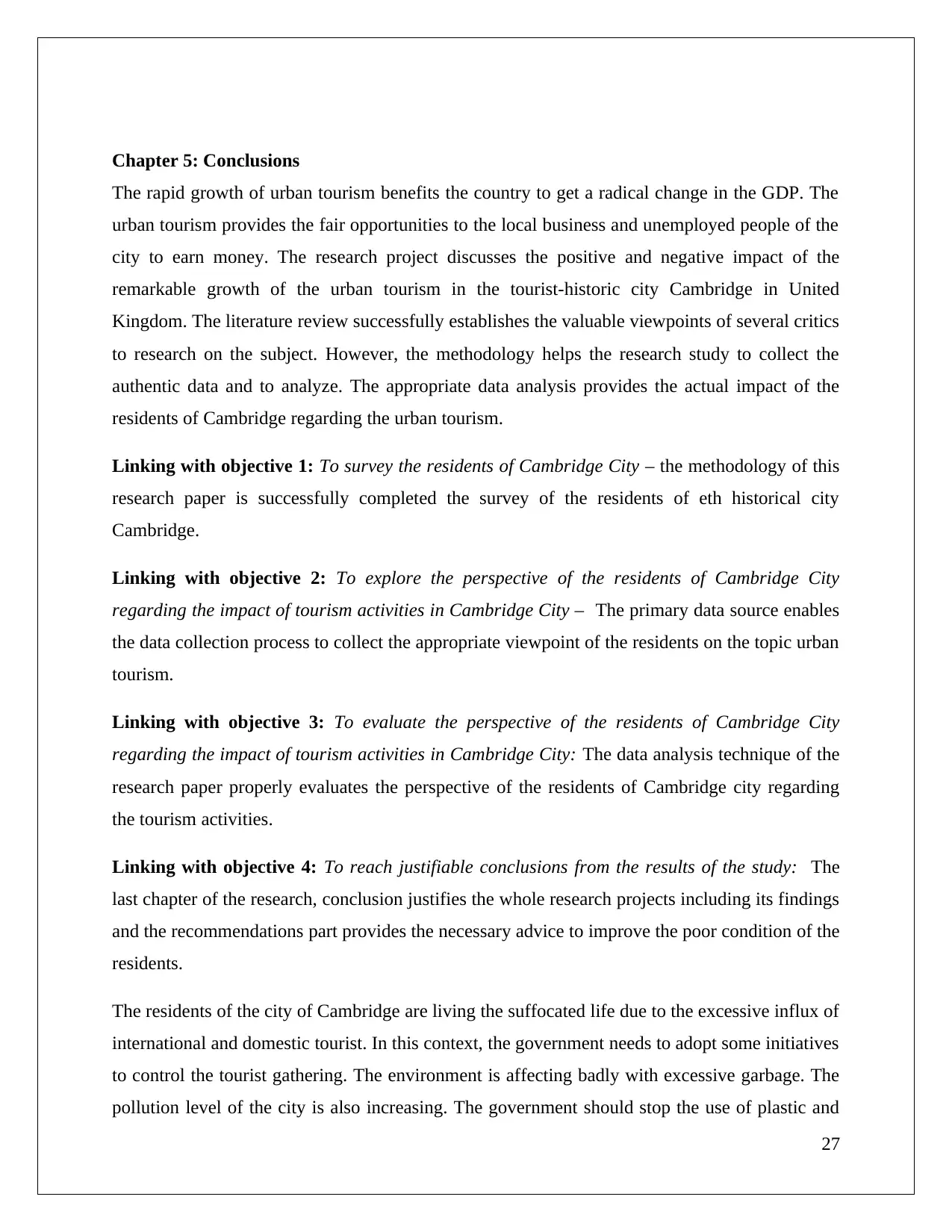
Chapter 5: Conclusions
The rapid growth of urban tourism benefits the country to get a radical change in the GDP. The
urban tourism provides the fair opportunities to the local business and unemployed people of the
city to earn money. The research project discusses the positive and negative impact of the
remarkable growth of the urban tourism in the tourist-historic city Cambridge in United
Kingdom. The literature review successfully establishes the valuable viewpoints of several critics
to research on the subject. However, the methodology helps the research study to collect the
authentic data and to analyze. The appropriate data analysis provides the actual impact of the
residents of Cambridge regarding the urban tourism.
Linking with objective 1: To survey the residents of Cambridge City – the methodology of this
research paper is successfully completed the survey of the residents of eth historical city
Cambridge.
Linking with objective 2: To explore the perspective of the residents of Cambridge City
regarding the impact of tourism activities in Cambridge City – The primary data source enables
the data collection process to collect the appropriate viewpoint of the residents on the topic urban
tourism.
Linking with objective 3: To evaluate the perspective of the residents of Cambridge City
regarding the impact of tourism activities in Cambridge City: The data analysis technique of the
research paper properly evaluates the perspective of the residents of Cambridge city regarding
the tourism activities.
Linking with objective 4: To reach justifiable conclusions from the results of the study: The
last chapter of the research, conclusion justifies the whole research projects including its findings
and the recommendations part provides the necessary advice to improve the poor condition of the
residents.
The residents of the city of Cambridge are living the suffocated life due to the excessive influx of
international and domestic tourist. In this context, the government needs to adopt some initiatives
to control the tourist gathering. The environment is affecting badly with excessive garbage. The
pollution level of the city is also increasing. The government should stop the use of plastic and
27
The rapid growth of urban tourism benefits the country to get a radical change in the GDP. The
urban tourism provides the fair opportunities to the local business and unemployed people of the
city to earn money. The research project discusses the positive and negative impact of the
remarkable growth of the urban tourism in the tourist-historic city Cambridge in United
Kingdom. The literature review successfully establishes the valuable viewpoints of several critics
to research on the subject. However, the methodology helps the research study to collect the
authentic data and to analyze. The appropriate data analysis provides the actual impact of the
residents of Cambridge regarding the urban tourism.
Linking with objective 1: To survey the residents of Cambridge City – the methodology of this
research paper is successfully completed the survey of the residents of eth historical city
Cambridge.
Linking with objective 2: To explore the perspective of the residents of Cambridge City
regarding the impact of tourism activities in Cambridge City – The primary data source enables
the data collection process to collect the appropriate viewpoint of the residents on the topic urban
tourism.
Linking with objective 3: To evaluate the perspective of the residents of Cambridge City
regarding the impact of tourism activities in Cambridge City: The data analysis technique of the
research paper properly evaluates the perspective of the residents of Cambridge city regarding
the tourism activities.
Linking with objective 4: To reach justifiable conclusions from the results of the study: The
last chapter of the research, conclusion justifies the whole research projects including its findings
and the recommendations part provides the necessary advice to improve the poor condition of the
residents.
The residents of the city of Cambridge are living the suffocated life due to the excessive influx of
international and domestic tourist. In this context, the government needs to adopt some initiatives
to control the tourist gathering. The environment is affecting badly with excessive garbage. The
pollution level of the city is also increasing. The government should stop the use of plastic and
27
Paraphrase This Document
Need a fresh take? Get an instant paraphrase of this document with our AI Paraphraser
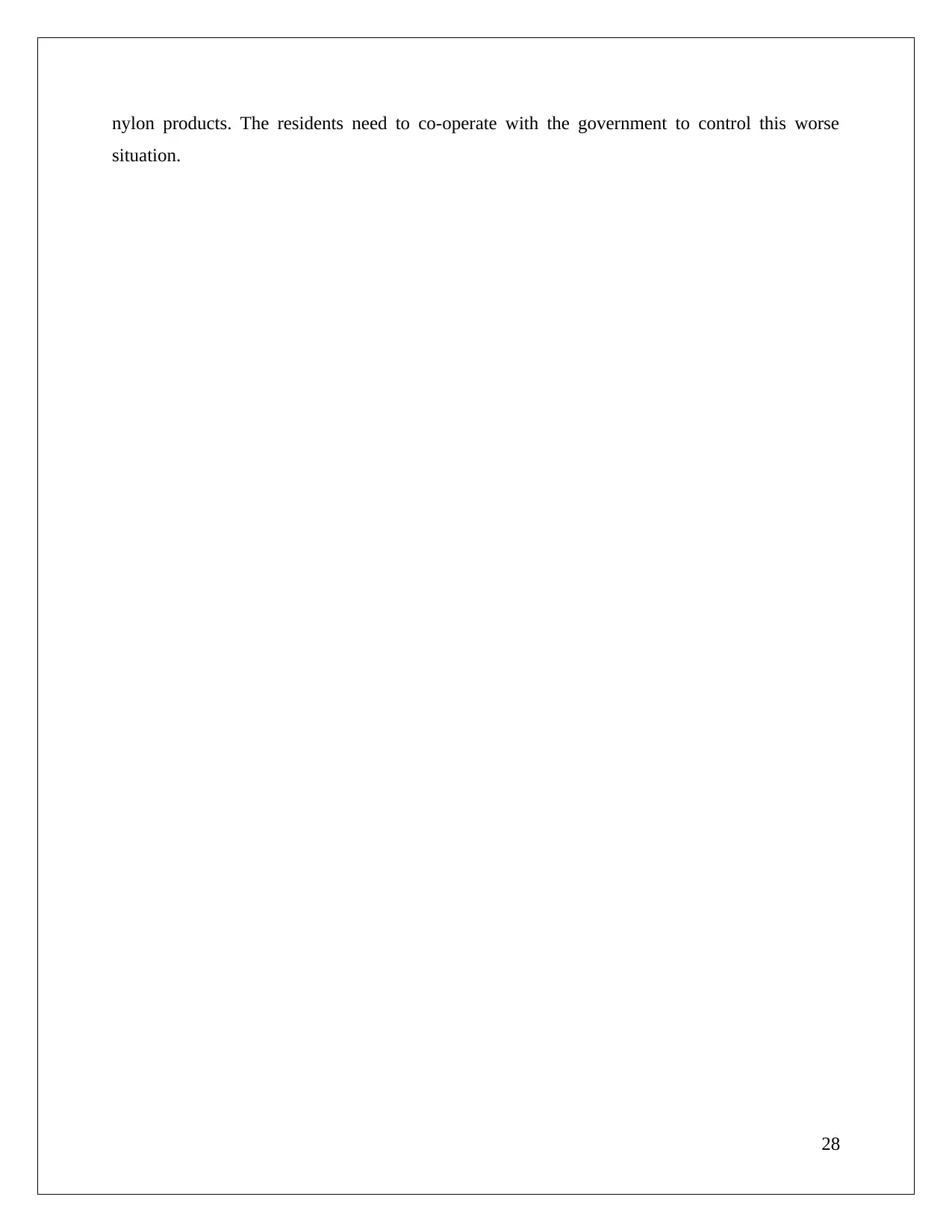
nylon products. The residents need to co-operate with the government to control this worse
situation.
28
situation.
28

References
AlSayyad, N., 2013. Consuming tradition, manufacturing heritage: global norms and urban
forms in the age of tourism. Routledge.
Ashworth, G.J., 2013. From history to heritage–from heritage to identity. Building a new
heritage: Tourism, culture and identity in the new Europe, pp.13-30.
Choy, L.T., 2014. The strengths and weaknesses of research methodology: Comparison and
complimentary between qualitative and quantitative approaches. IOSR Journal of Humanities
and Social Science, 19(4), pp.99-104.
Colomb, C. and Novy, J. eds., 2016. Protest and resistance in the tourist city. Routledge.
Flick, U., 2015. Introducing research methodology: A beginner's guide to doing a research
project. Sage.
García-Hernández, M., de la Calle-Vaquero, M. and Yubero, C., 2017. Cultural heritage and
urban tourism: Historic city centres under pressure. Sustainability, 9(8), p.1346.
González, S., 2011. Bilbao and Barcelona ‘in motion’. How urban regeneration ‘models’ travel
and mutate in the global flows of policy tourism. Urban Studies, 48(7), pp.1397-1418.
Mackey, A. and Gass, S.M., 2015. Second language research: Methodology and design.
Routledge.
McCusker, K. and Gunaydin, S., 2015. Research using qualitative, quantitative or mixed
methods and choice based on the research. Perfusion, 30(7), pp.537-542.
Miller, D., Merrilees, B. and Coghlan, A., 2015. Sustainable urban tourism: Understanding and
developing visitor pro-environmental behaviours. Journal of Sustainable Tourism, 23(1), pp.26-
46.
Mordue, T., 2017. New urban tourism and new urban citizenship: researching the creation and
management of postmodern urban public space. International Journal of Tourism Cities, 3(4),
pp.399-405.
29
AlSayyad, N., 2013. Consuming tradition, manufacturing heritage: global norms and urban
forms in the age of tourism. Routledge.
Ashworth, G.J., 2013. From history to heritage–from heritage to identity. Building a new
heritage: Tourism, culture and identity in the new Europe, pp.13-30.
Choy, L.T., 2014. The strengths and weaknesses of research methodology: Comparison and
complimentary between qualitative and quantitative approaches. IOSR Journal of Humanities
and Social Science, 19(4), pp.99-104.
Colomb, C. and Novy, J. eds., 2016. Protest and resistance in the tourist city. Routledge.
Flick, U., 2015. Introducing research methodology: A beginner's guide to doing a research
project. Sage.
García-Hernández, M., de la Calle-Vaquero, M. and Yubero, C., 2017. Cultural heritage and
urban tourism: Historic city centres under pressure. Sustainability, 9(8), p.1346.
González, S., 2011. Bilbao and Barcelona ‘in motion’. How urban regeneration ‘models’ travel
and mutate in the global flows of policy tourism. Urban Studies, 48(7), pp.1397-1418.
Mackey, A. and Gass, S.M., 2015. Second language research: Methodology and design.
Routledge.
McCusker, K. and Gunaydin, S., 2015. Research using qualitative, quantitative or mixed
methods and choice based on the research. Perfusion, 30(7), pp.537-542.
Miller, D., Merrilees, B. and Coghlan, A., 2015. Sustainable urban tourism: Understanding and
developing visitor pro-environmental behaviours. Journal of Sustainable Tourism, 23(1), pp.26-
46.
Mordue, T., 2017. New urban tourism and new urban citizenship: researching the creation and
management of postmodern urban public space. International Journal of Tourism Cities, 3(4),
pp.399-405.
29
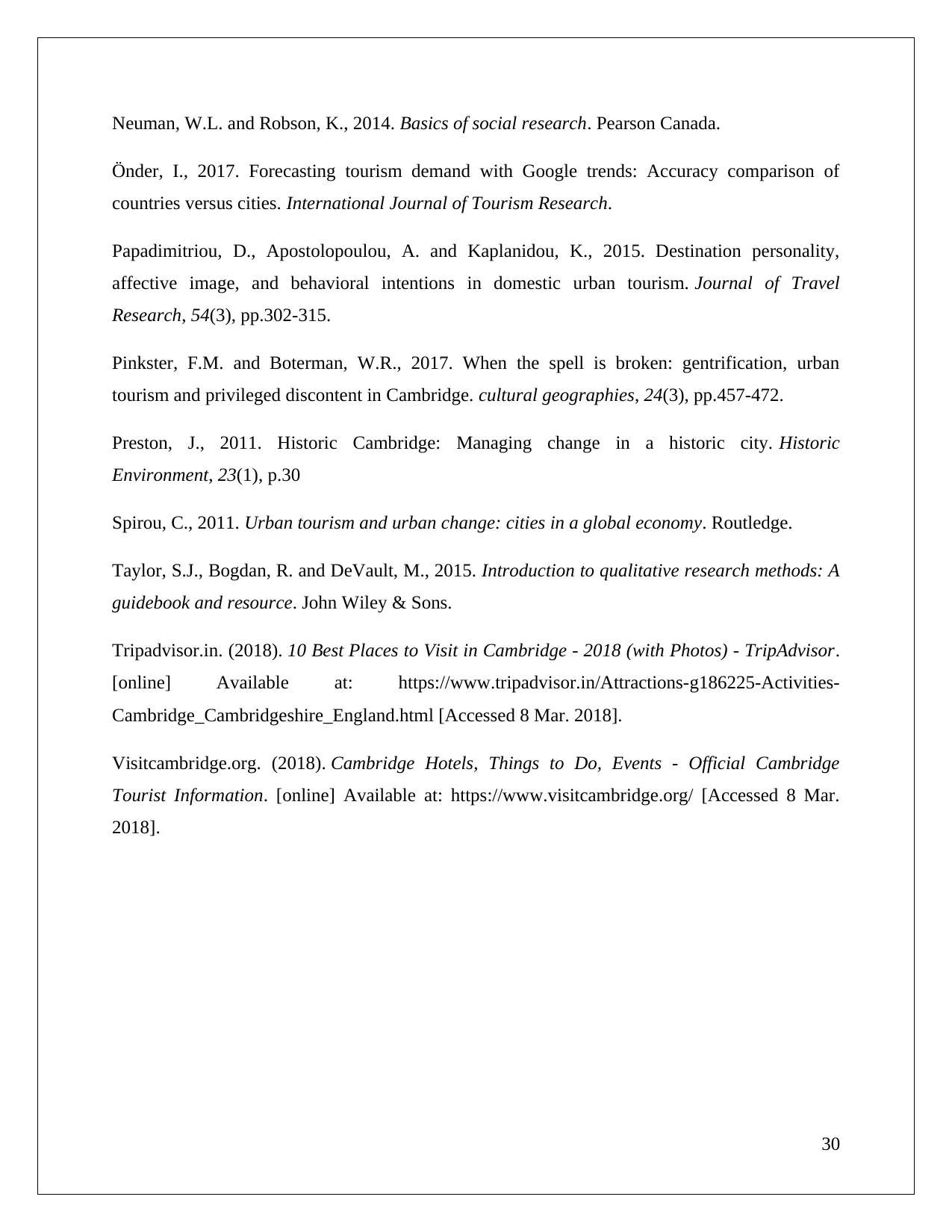
Neuman, W.L. and Robson, K., 2014. Basics of social research. Pearson Canada.
Önder, I., 2017. Forecasting tourism demand with Google trends: Accuracy comparison of
countries versus cities. International Journal of Tourism Research.
Papadimitriou, D., Apostolopoulou, A. and Kaplanidou, K., 2015. Destination personality,
affective image, and behavioral intentions in domestic urban tourism. Journal of Travel
Research, 54(3), pp.302-315.
Pinkster, F.M. and Boterman, W.R., 2017. When the spell is broken: gentrification, urban
tourism and privileged discontent in Cambridge. cultural geographies, 24(3), pp.457-472.
Preston, J., 2011. Historic Cambridge: Managing change in a historic city. Historic
Environment, 23(1), p.30
Spirou, C., 2011. Urban tourism and urban change: cities in a global economy. Routledge.
Taylor, S.J., Bogdan, R. and DeVault, M., 2015. Introduction to qualitative research methods: A
guidebook and resource. John Wiley & Sons.
Tripadvisor.in. (2018). 10 Best Places to Visit in Cambridge - 2018 (with Photos) - TripAdvisor.
[online] Available at: https://www.tripadvisor.in/Attractions-g186225-Activities-
Cambridge_Cambridgeshire_England.html [Accessed 8 Mar. 2018].
Visitcambridge.org. (2018). Cambridge Hotels, Things to Do, Events - Official Cambridge
Tourist Information. [online] Available at: https://www.visitcambridge.org/ [Accessed 8 Mar.
2018].
30
Önder, I., 2017. Forecasting tourism demand with Google trends: Accuracy comparison of
countries versus cities. International Journal of Tourism Research.
Papadimitriou, D., Apostolopoulou, A. and Kaplanidou, K., 2015. Destination personality,
affective image, and behavioral intentions in domestic urban tourism. Journal of Travel
Research, 54(3), pp.302-315.
Pinkster, F.M. and Boterman, W.R., 2017. When the spell is broken: gentrification, urban
tourism and privileged discontent in Cambridge. cultural geographies, 24(3), pp.457-472.
Preston, J., 2011. Historic Cambridge: Managing change in a historic city. Historic
Environment, 23(1), p.30
Spirou, C., 2011. Urban tourism and urban change: cities in a global economy. Routledge.
Taylor, S.J., Bogdan, R. and DeVault, M., 2015. Introduction to qualitative research methods: A
guidebook and resource. John Wiley & Sons.
Tripadvisor.in. (2018). 10 Best Places to Visit in Cambridge - 2018 (with Photos) - TripAdvisor.
[online] Available at: https://www.tripadvisor.in/Attractions-g186225-Activities-
Cambridge_Cambridgeshire_England.html [Accessed 8 Mar. 2018].
Visitcambridge.org. (2018). Cambridge Hotels, Things to Do, Events - Official Cambridge
Tourist Information. [online] Available at: https://www.visitcambridge.org/ [Accessed 8 Mar.
2018].
30
Secure Best Marks with AI Grader
Need help grading? Try our AI Grader for instant feedback on your assignments.

Appendix
Sample Survey Questionnaire
1. Specify your gender
Options Response
Female
Male
Others
2. To which age group do you belong?
Options Response
20-30
31-41
above 42
3. What according to you are the impacts of the urban tourism in Cambridge?
Options Response
Reduced unemployment
Growth of the cottage
and the ancillary
industry
Adverse impacts on the
environment
Impacts on the
originality of the place
31
Sample Survey Questionnaire
1. Specify your gender
Options Response
Female
Male
Others
2. To which age group do you belong?
Options Response
20-30
31-41
above 42
3. What according to you are the impacts of the urban tourism in Cambridge?
Options Response
Reduced unemployment
Growth of the cottage
and the ancillary
industry
Adverse impacts on the
environment
Impacts on the
originality of the place
31

4. Do you think that the culture and the society of Cambridge are greatly affected by these?
Options Response
yes
no
may be
5. Are you satisfied with the positive impacts of the urban tourism existing in your place?
Options Response
Highly satisfied
Satisfied
Neutral
Dis satisfied
Highly dissatisfied
6. According to you what are the factors that have contributed towards the overall
development of urban tourism of the place?
Options Response
historic monuments
scenic beauty
effective infrastructure
good lodging facilities
7. How far do you agree that Urban tourism has positive impacts on the local business of the
historical city of Cambridge?
Options Response
32
Options Response
yes
no
may be
5. Are you satisfied with the positive impacts of the urban tourism existing in your place?
Options Response
Highly satisfied
Satisfied
Neutral
Dis satisfied
Highly dissatisfied
6. According to you what are the factors that have contributed towards the overall
development of urban tourism of the place?
Options Response
historic monuments
scenic beauty
effective infrastructure
good lodging facilities
7. How far do you agree that Urban tourism has positive impacts on the local business of the
historical city of Cambridge?
Options Response
32
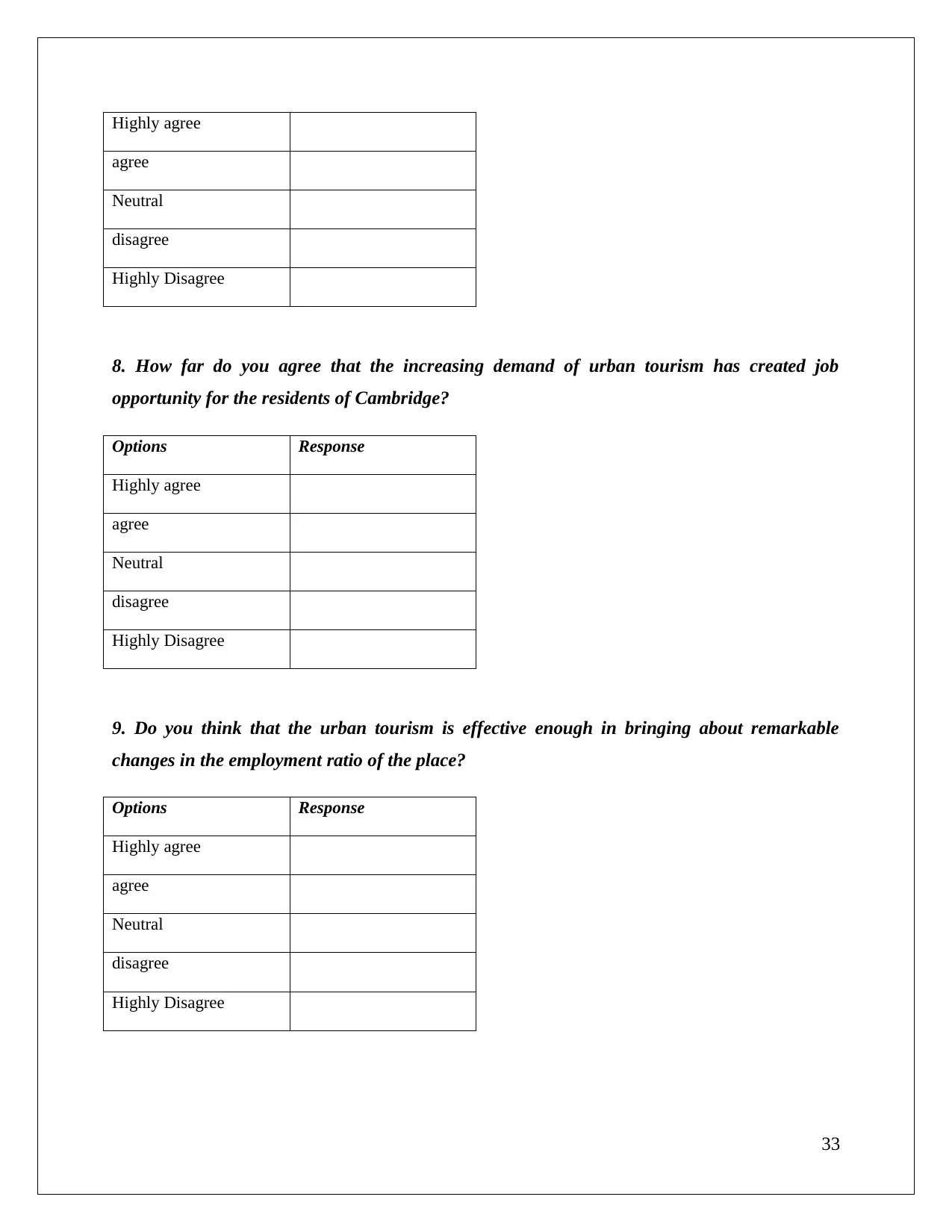
Highly agree
agree
Neutral
disagree
Highly Disagree
8. How far do you agree that the increasing demand of urban tourism has created job
opportunity for the residents of Cambridge?
Options Response
Highly agree
agree
Neutral
disagree
Highly Disagree
9. Do you think that the urban tourism is effective enough in bringing about remarkable
changes in the employment ratio of the place?
Options Response
Highly agree
agree
Neutral
disagree
Highly Disagree
33
agree
Neutral
disagree
Highly Disagree
8. How far do you agree that the increasing demand of urban tourism has created job
opportunity for the residents of Cambridge?
Options Response
Highly agree
agree
Neutral
disagree
Highly Disagree
9. Do you think that the urban tourism is effective enough in bringing about remarkable
changes in the employment ratio of the place?
Options Response
Highly agree
agree
Neutral
disagree
Highly Disagree
33
Paraphrase This Document
Need a fresh take? Get an instant paraphrase of this document with our AI Paraphraser
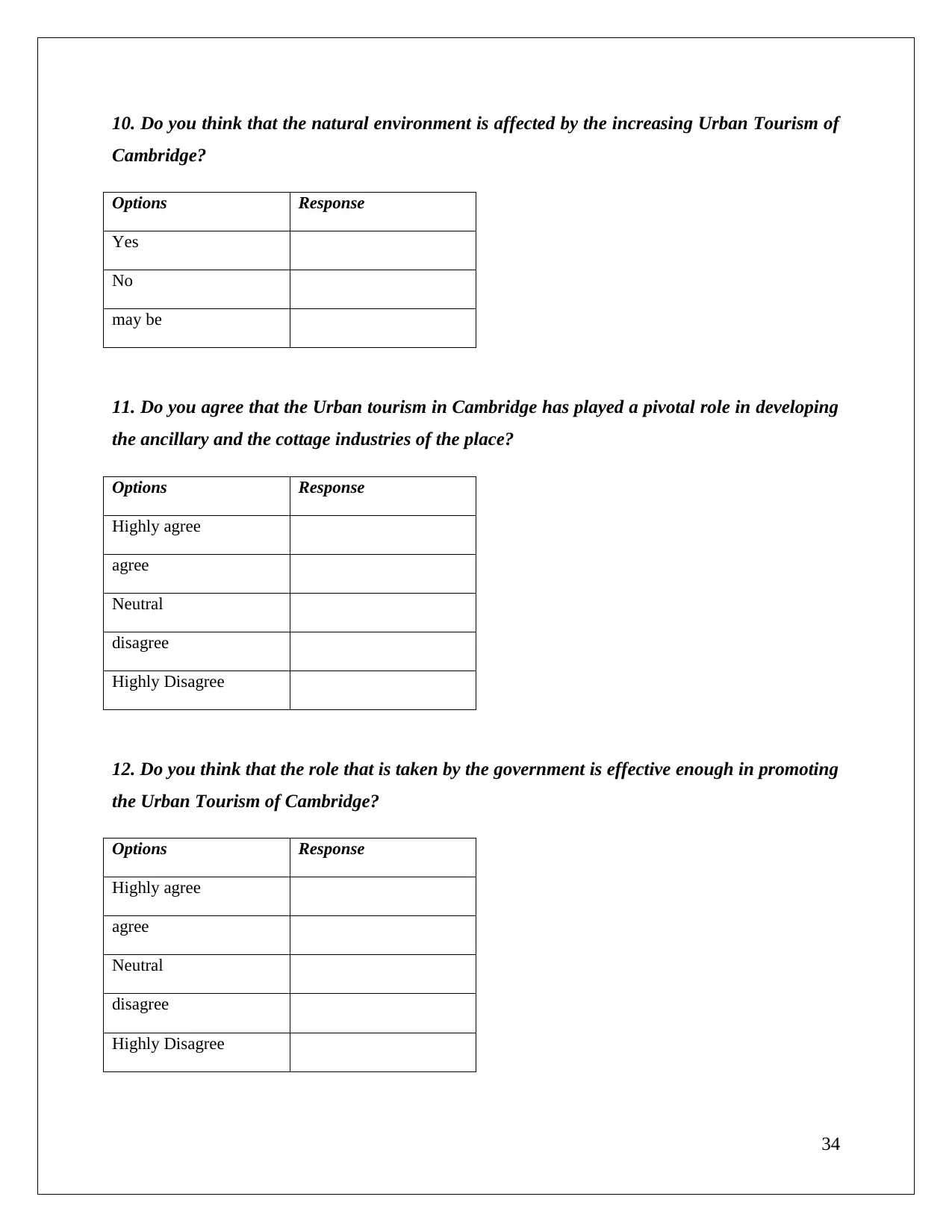
10. Do you think that the natural environment is affected by the increasing Urban Tourism of
Cambridge?
Options Response
Yes
No
may be
11. Do you agree that the Urban tourism in Cambridge has played a pivotal role in developing
the ancillary and the cottage industries of the place?
Options Response
Highly agree
agree
Neutral
disagree
Highly Disagree
12. Do you think that the role that is taken by the government is effective enough in promoting
the Urban Tourism of Cambridge?
Options Response
Highly agree
agree
Neutral
disagree
Highly Disagree
34
Cambridge?
Options Response
Yes
No
may be
11. Do you agree that the Urban tourism in Cambridge has played a pivotal role in developing
the ancillary and the cottage industries of the place?
Options Response
Highly agree
agree
Neutral
disagree
Highly Disagree
12. Do you think that the role that is taken by the government is effective enough in promoting
the Urban Tourism of Cambridge?
Options Response
Highly agree
agree
Neutral
disagree
Highly Disagree
34
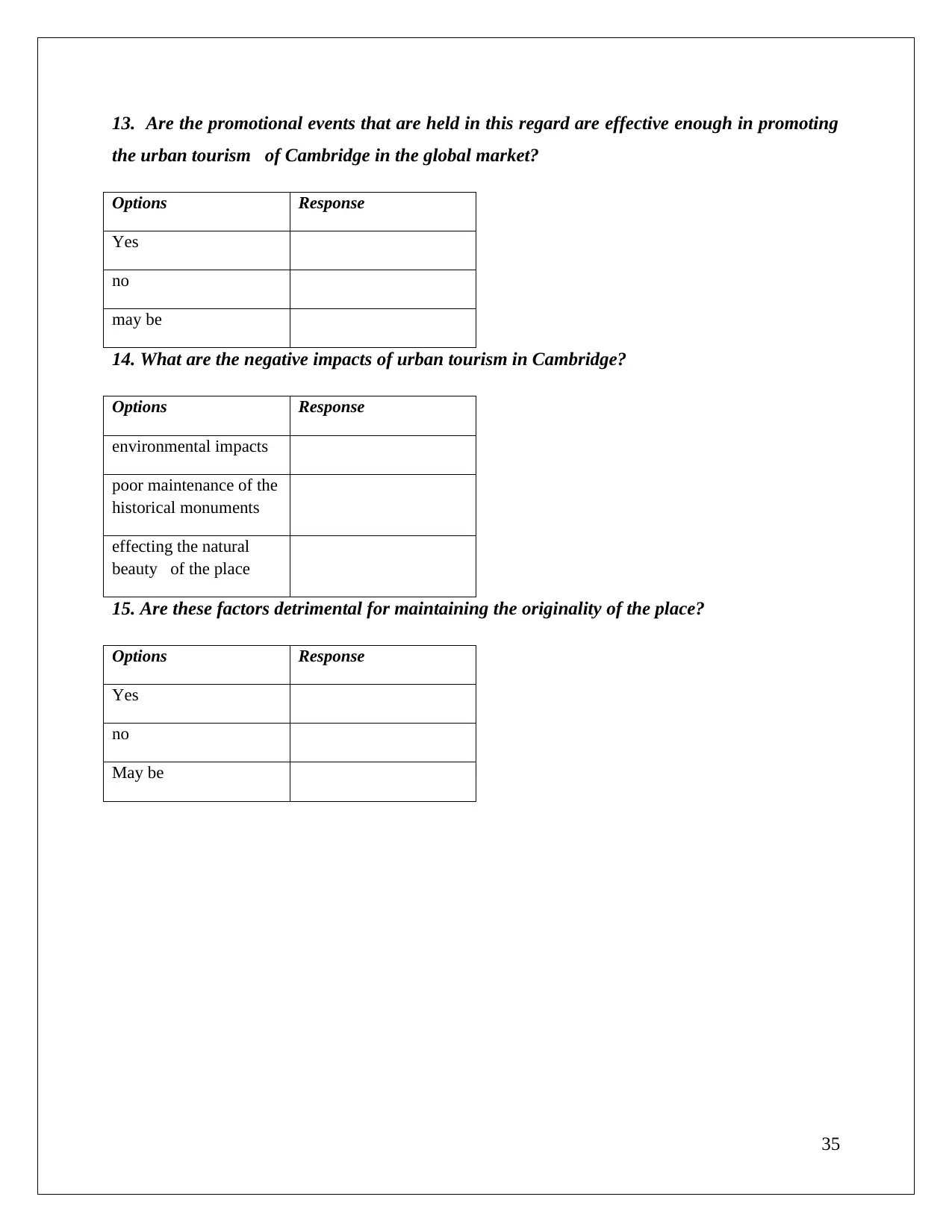
13. Are the promotional events that are held in this regard are effective enough in promoting
the urban tourism of Cambridge in the global market?
Options Response
Yes
no
may be
14. What are the negative impacts of urban tourism in Cambridge?
Options Response
environmental impacts
poor maintenance of the
historical monuments
effecting the natural
beauty of the place
15. Are these factors detrimental for maintaining the originality of the place?
Options Response
Yes
no
May be
35
the urban tourism of Cambridge in the global market?
Options Response
Yes
no
may be
14. What are the negative impacts of urban tourism in Cambridge?
Options Response
environmental impacts
poor maintenance of the
historical monuments
effecting the natural
beauty of the place
15. Are these factors detrimental for maintaining the originality of the place?
Options Response
Yes
no
May be
35
1 out of 36
![[object Object]](/_next/static/media/star-bottom.7253800d.svg)





